Pacific, MO Map & Demographics
Pacific Map
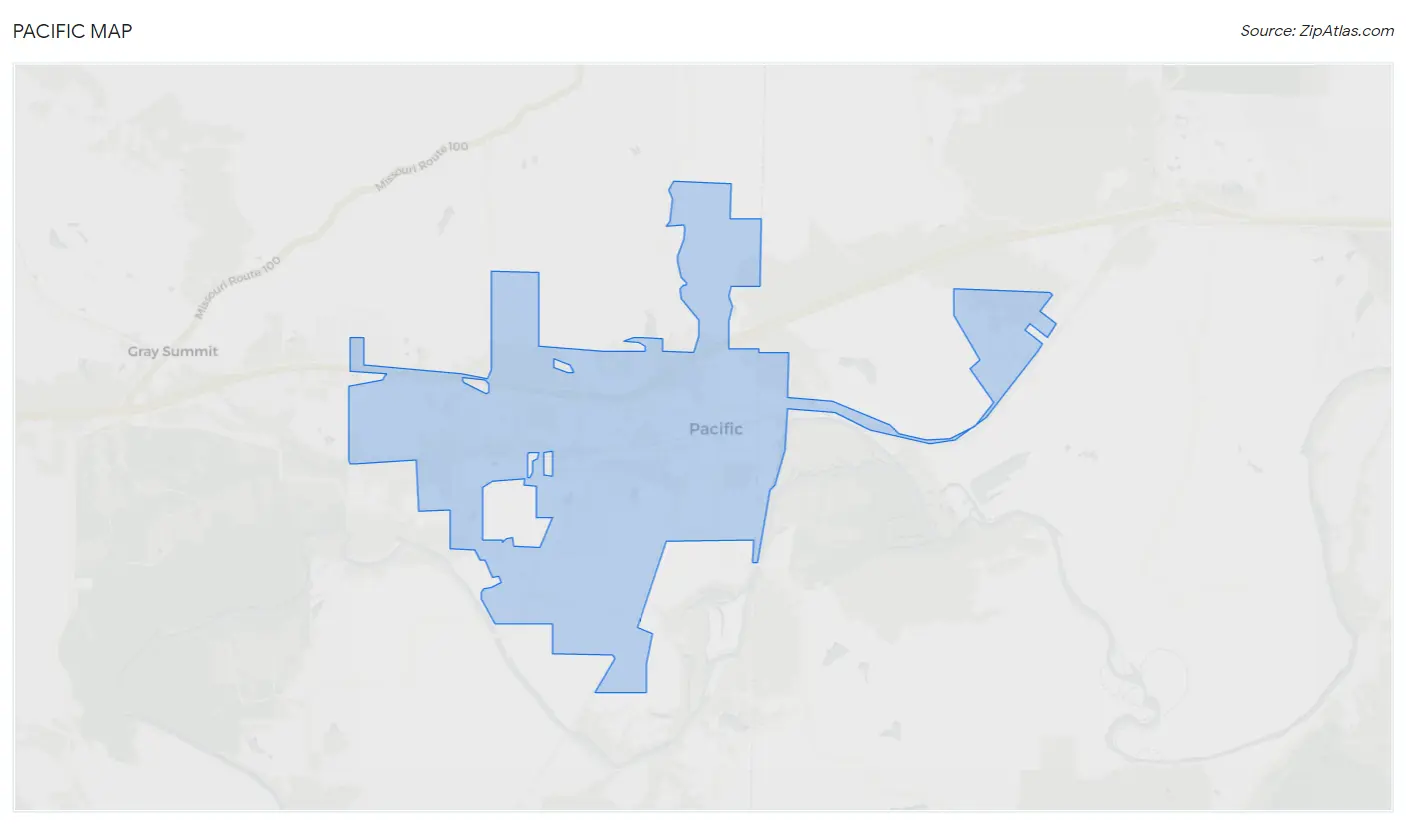
Pacific Overview
$30,527
PER CAPITA INCOME
$86,042
AVG FAMILY INCOME
$52,155
AVG HOUSEHOLD INCOME
32.7%
WAGE / INCOME GAP [ % ]
67.3¢/ $1
WAGE / INCOME GAP [ $ ]
0.42
INEQUALITY / GINI INDEX
7,239
TOTAL POPULATION
3,979
MALE POPULATION
3,260
FEMALE POPULATION
122.06
MALES / 100 FEMALES
81.93
FEMALES / 100 MALES
39.6
MEDIAN AGE
2.9
AVG FAMILY SIZE
2.0
AVG HOUSEHOLD SIZE
3,660
LABOR FORCE [ PEOPLE ]
58.8%
PERCENT IN LABOR FORCE
1.5%
UNEMPLOYMENT RATE
Pacific Zip Codes
Pacific Area Codes
Income in Pacific
Income Overview in Pacific
Per Capita Income in Pacific is $30,527, while median incomes of families and households are $86,042 and $52,155 respectively.
| Characteristic | Number | Measure |
| Per Capita Income | 7,239 | $30,527 |
| Median Family Income | 1,522 | $86,042 |
| Mean Family Income | 1,522 | $100,676 |
| Median Household Income | 3,115 | $52,155 |
| Mean Household Income | 3,115 | $69,344 |
| Income Deficit | 1,522 | $0 |
| Wage / Income Gap (%) | 7,239 | 32.65% |
| Wage / Income Gap ($) | 7,239 | 67.35¢ per $1 |
| Gini / Inequality Index | 7,239 | 0.42 |
Earnings by Sex in Pacific
Average Earnings in Pacific are $38,244, $45,066 for men and $30,350 for women, a difference of 32.7%.

| Sex | Number | Average Earnings |
| Male | 2,080 (52.3%) | $45,066 |
| Female | 1,895 (47.7%) | $30,350 |
| Total | 3,975 (100.0%) | $38,244 |
Earnings by Sex by Income Bracket in Pacific
The most common earnings brackets in Pacific are $55,000 to $64,999 for men (221 | 10.6%) and $20,000 to $22,499 for women (220 | 11.6%).
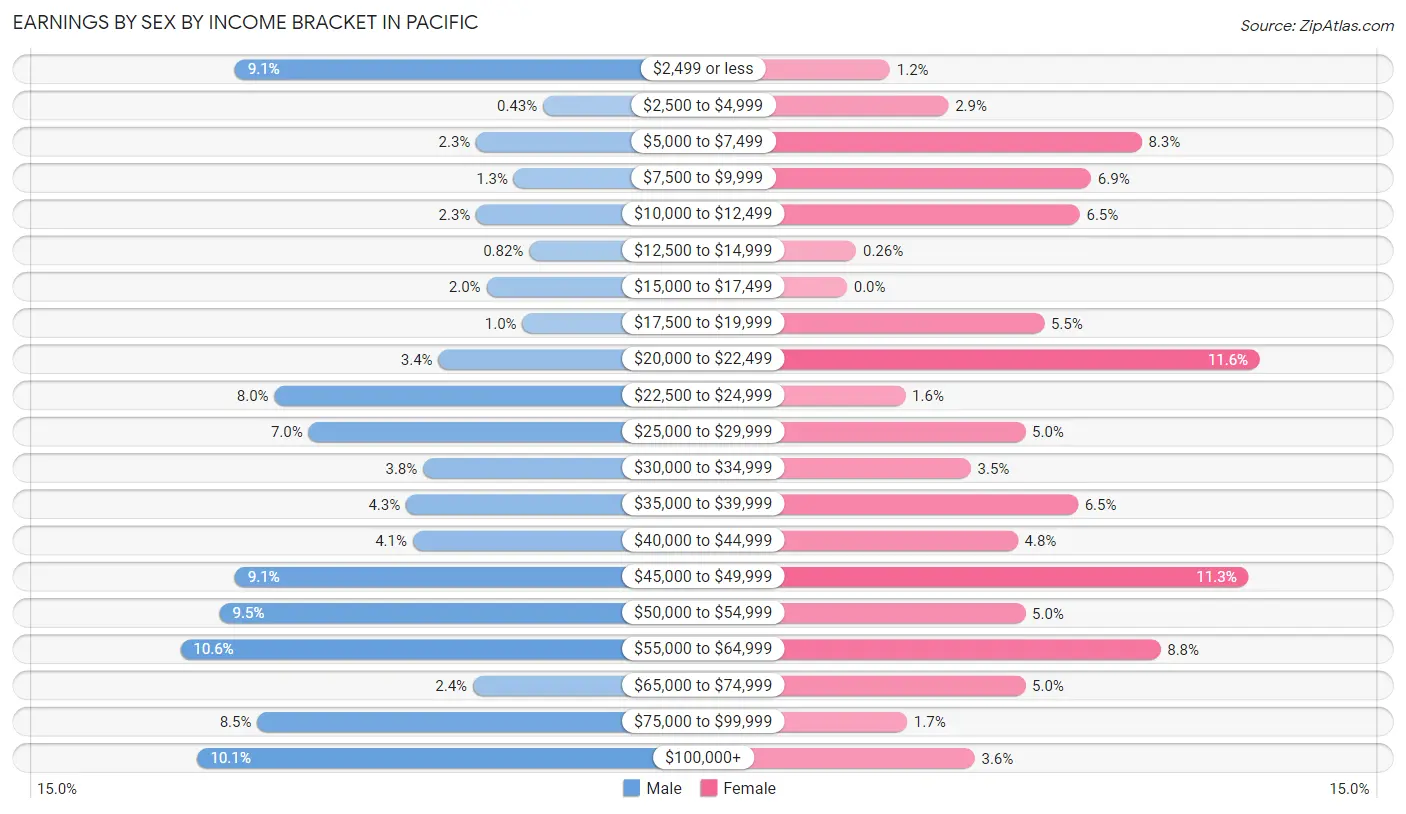
| Income | Male | Female |
| $2,499 or less | 189 (9.1%) | 23 (1.2%) |
| $2,500 to $4,999 | 9 (0.4%) | 54 (2.9%) |
| $5,000 to $7,499 | 48 (2.3%) | 157 (8.3%) |
| $7,500 to $9,999 | 26 (1.3%) | 130 (6.9%) |
| $10,000 to $12,499 | 48 (2.3%) | 124 (6.5%) |
| $12,500 to $14,999 | 17 (0.8%) | 5 (0.3%) |
| $15,000 to $17,499 | 42 (2.0%) | 0 (0.0%) |
| $17,500 to $19,999 | 21 (1.0%) | 105 (5.5%) |
| $20,000 to $22,499 | 70 (3.4%) | 220 (11.6%) |
| $22,500 to $24,999 | 166 (8.0%) | 31 (1.6%) |
| $25,000 to $29,999 | 146 (7.0%) | 95 (5.0%) |
| $30,000 to $34,999 | 79 (3.8%) | 66 (3.5%) |
| $35,000 to $39,999 | 89 (4.3%) | 123 (6.5%) |
| $40,000 to $44,999 | 85 (4.1%) | 91 (4.8%) |
| $45,000 to $49,999 | 189 (9.1%) | 214 (11.3%) |
| $50,000 to $54,999 | 198 (9.5%) | 95 (5.0%) |
| $55,000 to $64,999 | 221 (10.6%) | 167 (8.8%) |
| $65,000 to $74,999 | 50 (2.4%) | 95 (5.0%) |
| $75,000 to $99,999 | 176 (8.5%) | 32 (1.7%) |
| $100,000+ | 211 (10.1%) | 68 (3.6%) |
| Total | 2,080 (100.0%) | 1,895 (100.0%) |
Earnings by Sex by Educational Attainment in Pacific
Average earnings in Pacific are $45,541 for men and $45,870 for women, a difference of 0.7%. Men with an educational attainment of less than high school enjoy the highest average annual earnings of $46,731, while those with college or associate's degree education earn the least with $42,558. Women with an educational attainment of graduate degree earn the most with the average annual earnings of $67,773, while those with college or associate's degree education have the smallest earnings of $36,618.

| Educational Attainment | Male Income | Female Income |
| Less than High School | $46,731 | $0 |
| High School Diploma | $46,591 | $39,088 |
| College or Associate's Degree | $42,558 | $36,618 |
| Bachelor's Degree | - | - |
| Graduate Degree | - | - |
| Total | $45,541 | $45,870 |
Family Income in Pacific
Family Income Brackets in Pacific
According to the Pacific family income data, there are 367 families falling into the $100,000 to $149,999 income range, which is the most common income bracket and makes up 24.1% of all families.

| Income Bracket | # Families | % Families |
| Less than $10,000 | 0 | 0.0% |
| $10,000 to $14,999 | 14 | 0.9% |
| $15,000 to $24,999 | 2 | 0.1% |
| $25,000 to $34,999 | 140 | 9.2% |
| $35,000 to $49,999 | 177 | 11.6% |
| $50,000 to $74,999 | 330 | 21.7% |
| $75,000 to $99,999 | 263 | 17.3% |
| $100,000 to $149,999 | 367 | 24.1% |
| $150,000 to $199,999 | 155 | 10.2% |
| $200,000+ | 76 | 5.0% |
Family Income by Famaliy Size in Pacific
5-person families (122 | 8.0%) account for the highest median family income in Pacific with $137,083 per family, while 2-person families (709 | 46.6%) have the highest median income of $34,786 per family member.

| Income Bracket | # Families | Median Income |
| 2-Person Families | 709 (46.6%) | $69,572 |
| 3-Person Families | 522 (34.3%) | $82,652 |
| 4-Person Families | 169 (11.1%) | $125,450 |
| 5-Person Families | 122 (8.0%) | $137,083 |
| 6-Person Families | 0 (0.0%) | $0 |
| 7+ Person Families | 0 (0.0%) | $0 |
| Total | 1,522 (100.0%) | $86,042 |
Family Income by Number of Earners in Pacific
The median family income in Pacific is $86,042, with families comprising 3+ earners (171) having the highest median family income of $125,852, while families with 1 earner (429) have the lowest median family income of $54,961, accounting for 11.2% and 28.2% of families, respectively.

| Number of Earners | # Families | Median Income |
| No Earners | 147 (9.7%) | $66,935 |
| 1 Earner | 429 (28.2%) | $54,961 |
| 2 Earners | 775 (50.9%) | $91,913 |
| 3+ Earners | 171 (11.2%) | $125,852 |
| Total | 1,522 (100.0%) | $86,042 |
Household Income in Pacific
Household Income Brackets in Pacific
With 670 households falling in the category, the $50,000 to $74,999 income range is the most frequent in Pacific, accounting for 21.5% of all households. In contrast, only 47 households (1.5%) fall into the $10,000 to $14,999 income bracket, making it the least populous group.

| Income Bracket | # Households | % Households |
| Less than $10,000 | 59 | 1.9% |
| $10,000 to $14,999 | 47 | 1.5% |
| $15,000 to $24,999 | 592 | 19.0% |
| $25,000 to $34,999 | 361 | 11.6% |
| $35,000 to $49,999 | 433 | 13.9% |
| $50,000 to $74,999 | 670 | 21.5% |
| $75,000 to $99,999 | 259 | 8.3% |
| $100,000 to $149,999 | 455 | 14.6% |
| $150,000 to $199,999 | 162 | 5.2% |
| $200,000+ | 75 | 2.4% |
Household Income by Householder Age in Pacific
The median household income in Pacific is $52,155, with the highest median household income of $69,716 found in the 25 to 44 years age bracket for the primary householder. A total of 943 households (30.3%) fall into this category. Meanwhile, the 15 to 24 years age bracket for the primary householder has the lowest median household income of $22,128, with 303 households (9.7%) in this group.

| Income Bracket | # Households | Median Income |
| 15 to 24 Years | 303 (9.7%) | $22,128 |
| 25 to 44 Years | 943 (30.3%) | $69,716 |
| 45 to 64 Years | 1,037 (33.3%) | $40,694 |
| 65+ Years | 832 (26.7%) | $46,250 |
| Total | 3,115 (100.0%) | $52,155 |
Poverty in Pacific
Income Below Poverty by Sex and Age in Pacific
With 3.6% poverty level for males and 8.9% for females among the residents of Pacific, 45 to 54 year old males and 12 to 14 year old females are the most vulnerable to poverty, with 31 males (10.7%) and 17 females (65.4%) in their respective age groups living below the poverty level.
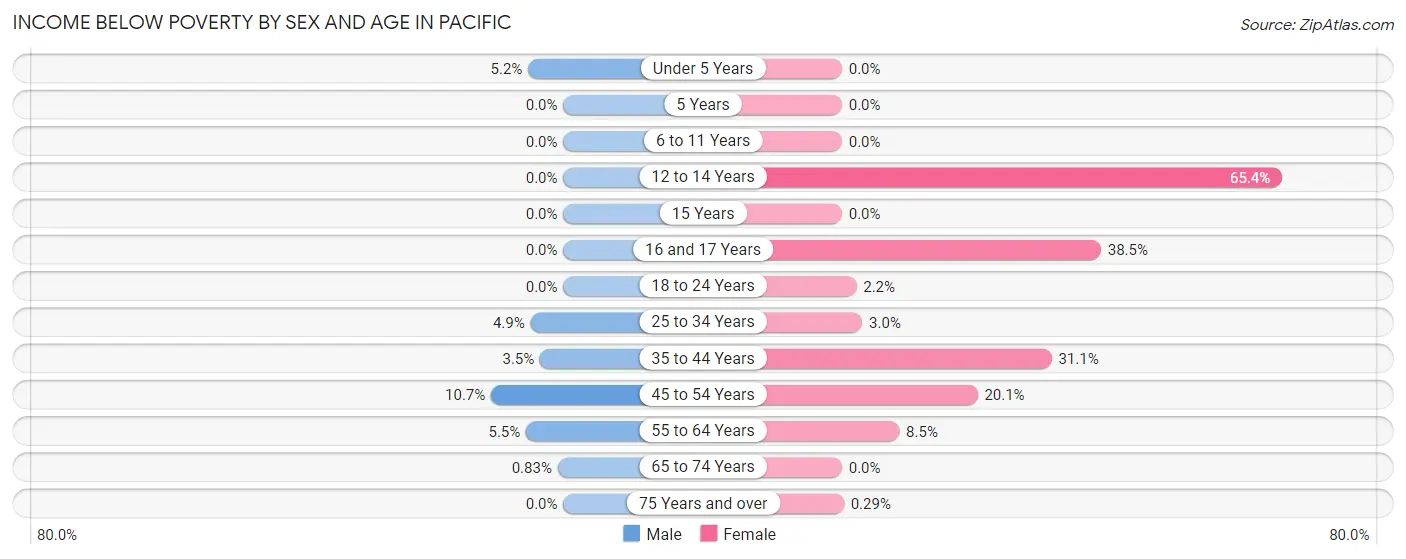
| Age Bracket | Male | Female |
| Under 5 Years | 12 (5.2%) | 0 (0.0%) |
| 5 Years | 0 (0.0%) | 0 (0.0%) |
| 6 to 11 Years | 0 (0.0%) | 0 (0.0%) |
| 12 to 14 Years | 0 (0.0%) | 17 (65.4%) |
| 15 Years | 0 (0.0%) | 0 (0.0%) |
| 16 and 17 Years | 0 (0.0%) | 15 (38.5%) |
| 18 to 24 Years | 0 (0.0%) | 13 (2.1%) |
| 25 to 34 Years | 24 (4.9%) | 13 (3.0%) |
| 35 to 44 Years | 17 (3.5%) | 104 (31.1%) |
| 45 to 54 Years | 31 (10.7%) | 86 (20.1%) |
| 55 to 64 Years | 26 (5.5%) | 35 (8.5%) |
| 65 to 74 Years | 2 (0.8%) | 0 (0.0%) |
| 75 Years and over | 0 (0.0%) | 1 (0.3%) |
| Total | 112 (3.6%) | 284 (8.9%) |
Income Above Poverty by Sex and Age in Pacific
According to the poverty statistics in Pacific, males aged 5 years and females aged under 5 years are the age groups that are most secure financially, with 100.0% of males and 100.0% of females in these age groups living above the poverty line.
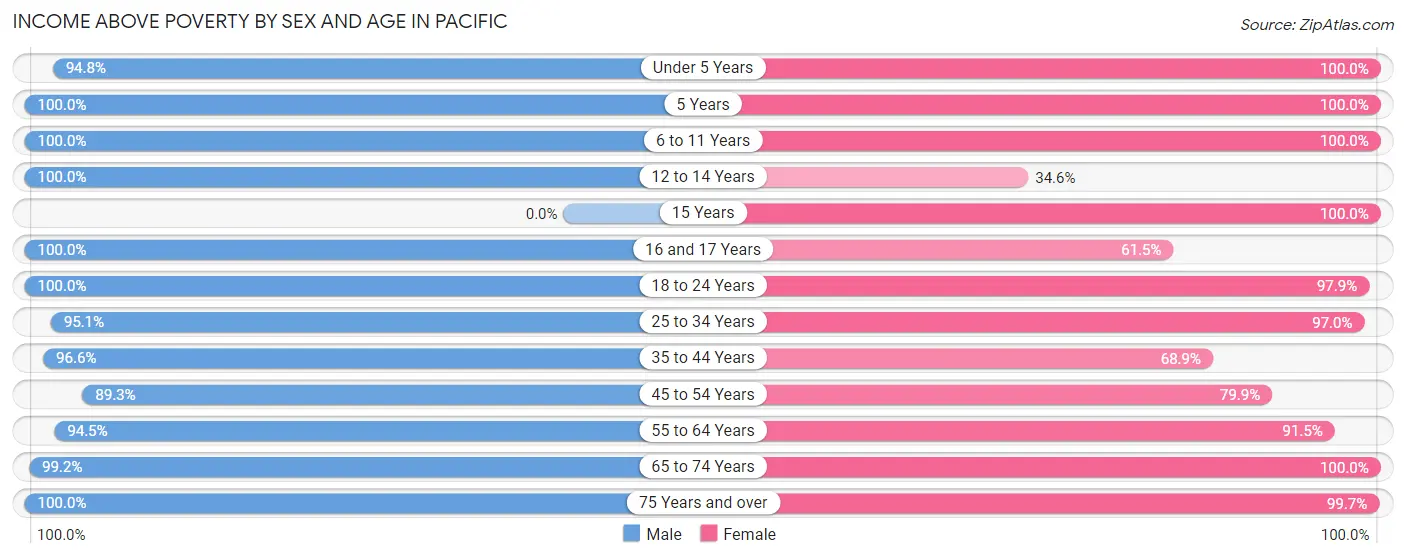
| Age Bracket | Male | Female |
| Under 5 Years | 218 (94.8%) | 133 (100.0%) |
| 5 Years | 82 (100.0%) | 19 (100.0%) |
| 6 to 11 Years | 145 (100.0%) | 124 (100.0%) |
| 12 to 14 Years | 215 (100.0%) | 9 (34.6%) |
| 15 Years | 0 (0.0%) | 40 (100.0%) |
| 16 and 17 Years | 45 (100.0%) | 24 (61.5%) |
| 18 to 24 Years | 180 (100.0%) | 593 (97.9%) |
| 25 to 34 Years | 469 (95.1%) | 417 (97.0%) |
| 35 to 44 Years | 476 (96.6%) | 230 (68.9%) |
| 45 to 54 Years | 258 (89.3%) | 341 (79.9%) |
| 55 to 64 Years | 444 (94.5%) | 376 (91.5%) |
| 65 to 74 Years | 238 (99.2%) | 268 (100.0%) |
| 75 Years and over | 247 (100.0%) | 349 (99.7%) |
| Total | 3,017 (96.4%) | 2,923 (91.1%) |
Income Below Poverty Among Married-Couple Families in Pacific
The poverty statistics for married-couple families in Pacific show that 1.4% or 17 of the total 1,180 families live below the poverty line. Families with 1 or 2 children have the highest poverty rate of 3.2%, comprising of 16 families. On the other hand, families with 3 or 4 children have the lowest poverty rate of 0.0%, which includes 0 families.

| Children | Above Poverty | Below Poverty |
| No Children | 654 (99.9%) | 1 (0.2%) |
| 1 or 2 Children | 481 (96.8%) | 16 (3.2%) |
| 3 or 4 Children | 28 (100.0%) | 0 (0.0%) |
| 5 or more Children | 0 (0.0%) | 0 (0.0%) |
| Total | 1,163 (98.6%) | 17 (1.4%) |
Income Below Poverty Among Single-Parent Households in Pacific

| Children | Single Father | Single Mother |
| No Children | 0 (0.0%) | 0 (0.0%) |
| 1 or 2 Children | 0 (0.0%) | 13 (13.4%) |
| 3 or 4 Children | 0 (0.0%) | 0 (0.0%) |
| 5 or more Children | 0 (0.0%) | 0 (0.0%) |
| Total | 0 (0.0%) | 13 (7.2%) |
Income Below Poverty Among Married-Couple vs Single-Parent Households in Pacific
The poverty data for Pacific shows that 17 of the married-couple family households (1.4%) and 13 of the single-parent households (3.8%) are living below the poverty level. Within the married-couple family households, those with 1 or 2 children have the highest poverty rate, with 16 households (3.2%) falling below the poverty line. Among the single-parent households, those with 1 or 2 children have the highest poverty rate, with 13 household (5.7%) living below poverty.

| Children | Married-Couple Families | Single-Parent Households |
| No Children | 1 (0.2%) | 0 (0.0%) |
| 1 or 2 Children | 16 (3.2%) | 13 (5.7%) |
| 3 or 4 Children | 0 (0.0%) | 0 (0.0%) |
| 5 or more Children | 0 (0.0%) | 0 (0.0%) |
| Total | 17 (1.4%) | 13 (3.8%) |
Race in Pacific
The most populous races in Pacific are White / Caucasian (6,045 | 83.5%), Two or more Races (656 | 9.1%), and Black / African American (485 | 6.7%).

| Race | # Population | % Population |
| Asian | 16 | 0.2% |
| Black / African American | 485 | 6.7% |
| Hawaiian / Pacific | 0 | 0.0% |
| Hispanic or Latino | 108 | 1.5% |
| Native / Alaskan | 30 | 0.4% |
| White / Caucasian | 6,045 | 83.5% |
| Two or more Races | 656 | 9.1% |
| Some other Race | 7 | 0.1% |
| Total | 7,239 | 100.0% |
Ancestry in Pacific
The most populous ancestries reported in Pacific are German (2,587 | 35.7%), Irish (1,556 | 21.5%), American (885 | 12.2%), English (636 | 8.8%), and French (206 | 2.9%), together accounting for 81.1% of all Pacific residents.
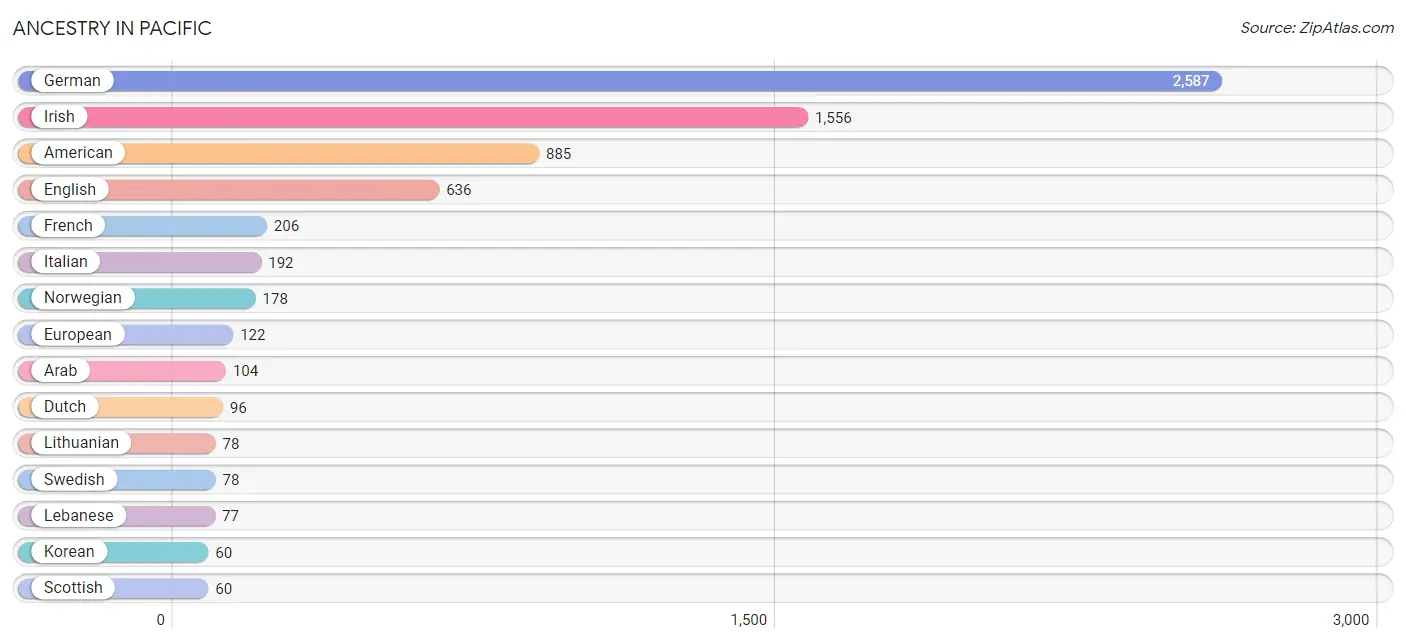
| Ancestry | # Population | % Population |
| American | 885 | 12.2% |
| Arab | 104 | 1.4% |
| Bhutanese | 5 | 0.1% |
| British | 32 | 0.4% |
| Central American | 45 | 0.6% |
| Cherokee | 39 | 0.5% |
| Chickasaw | 12 | 0.2% |
| Choctaw | 1 | 0.0% |
| Croatian | 10 | 0.1% |
| Czech | 47 | 0.6% |
| Dutch | 96 | 1.3% |
| Egyptian | 27 | 0.4% |
| English | 636 | 8.8% |
| European | 122 | 1.7% |
| French | 206 | 2.9% |
| German | 2,587 | 35.7% |
| Honduran | 27 | 0.4% |
| Irish | 1,556 | 21.5% |
| Italian | 192 | 2.6% |
| Korean | 60 | 0.8% |
| Lebanese | 77 | 1.1% |
| Lithuanian | 78 | 1.1% |
| Mexican | 56 | 0.8% |
| Norwegian | 178 | 2.5% |
| Polish | 12 | 0.2% |
| Portuguese | 36 | 0.5% |
| Puerto Rican | 7 | 0.1% |
| Romanian | 12 | 0.2% |
| Salvadoran | 18 | 0.3% |
| Scandinavian | 30 | 0.4% |
| Scotch-Irish | 53 | 0.7% |
| Scottish | 60 | 0.8% |
| Swedish | 78 | 1.1% |
| Swiss | 51 | 0.7% |
| Welsh | 27 | 0.4% |
| Yugoslavian | 21 | 0.3% | View All 36 Rows |
Immigrants in Pacific
The most numerous immigrant groups reported in Pacific came from Europe (28 | 0.4%), Central America (27 | 0.4%), Honduras (27 | 0.4%), Latin America (27 | 0.4%), and Eastern Europe (22 | 0.3%), together accounting for 1.8% of all Pacific residents.
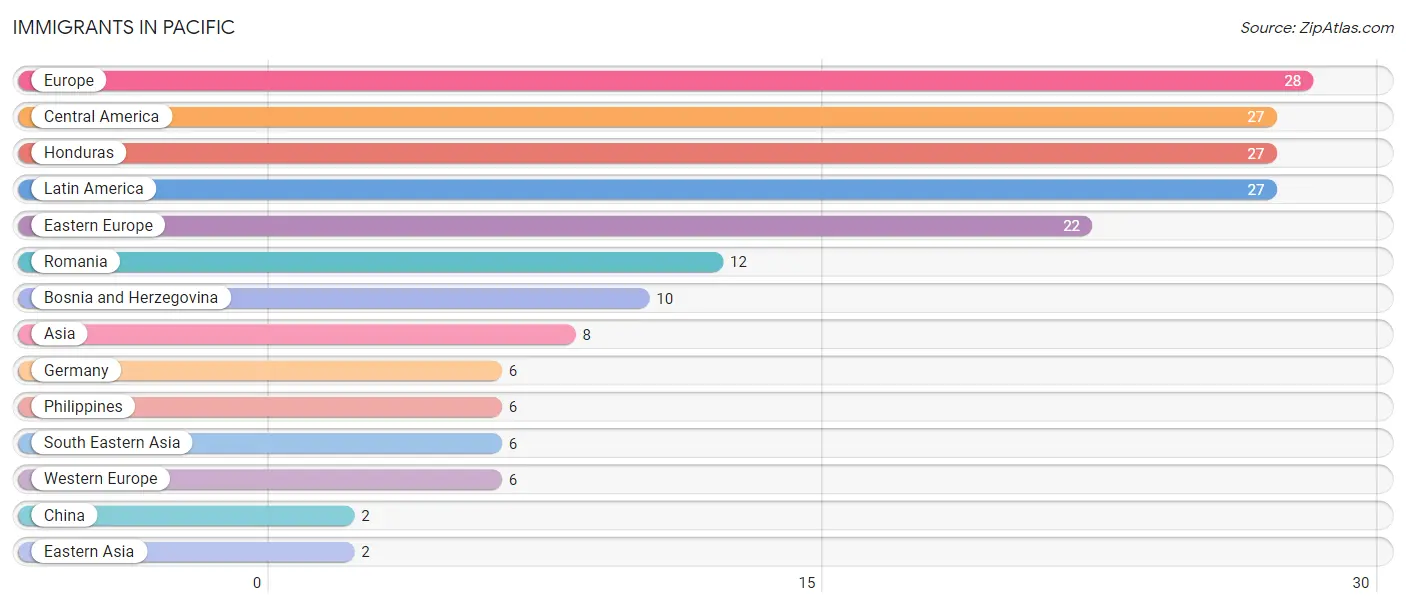
| Immigration Origin | # Population | % Population |
| Asia | 8 | 0.1% |
| Bosnia and Herzegovina | 10 | 0.1% |
| Central America | 27 | 0.4% |
| China | 2 | 0.0% |
| Eastern Asia | 2 | 0.0% |
| Eastern Europe | 22 | 0.3% |
| Europe | 28 | 0.4% |
| Germany | 6 | 0.1% |
| Honduras | 27 | 0.4% |
| Latin America | 27 | 0.4% |
| Philippines | 6 | 0.1% |
| Romania | 12 | 0.2% |
| South Eastern Asia | 6 | 0.1% |
| Western Europe | 6 | 0.1% | View All 14 Rows |
Sex and Age in Pacific
Sex and Age in Pacific
The most populous age groups in Pacific are 30 to 34 Years (448 | 11.3%) for men and 20 to 24 Years (373 | 11.4%) for women.
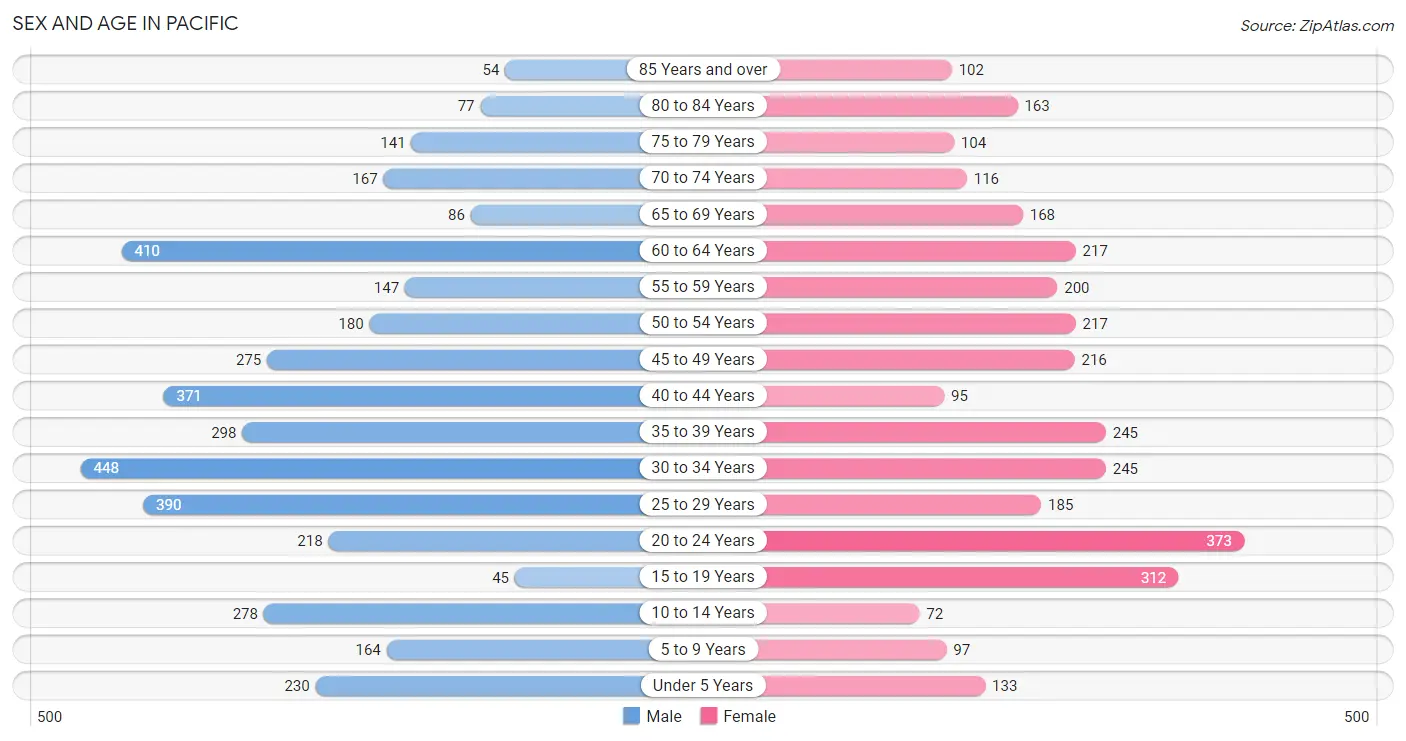
| Age Bracket | Male | Female |
| Under 5 Years | 230 (5.8%) | 133 (4.1%) |
| 5 to 9 Years | 164 (4.1%) | 97 (3.0%) |
| 10 to 14 Years | 278 (7.0%) | 72 (2.2%) |
| 15 to 19 Years | 45 (1.1%) | 312 (9.6%) |
| 20 to 24 Years | 218 (5.5%) | 373 (11.4%) |
| 25 to 29 Years | 390 (9.8%) | 185 (5.7%) |
| 30 to 34 Years | 448 (11.3%) | 245 (7.5%) |
| 35 to 39 Years | 298 (7.5%) | 245 (7.5%) |
| 40 to 44 Years | 371 (9.3%) | 95 (2.9%) |
| 45 to 49 Years | 275 (6.9%) | 216 (6.6%) |
| 50 to 54 Years | 180 (4.5%) | 217 (6.7%) |
| 55 to 59 Years | 147 (3.7%) | 200 (6.1%) |
| 60 to 64 Years | 410 (10.3%) | 217 (6.7%) |
| 65 to 69 Years | 86 (2.2%) | 168 (5.1%) |
| 70 to 74 Years | 167 (4.2%) | 116 (3.6%) |
| 75 to 79 Years | 141 (3.5%) | 104 (3.2%) |
| 80 to 84 Years | 77 (1.9%) | 163 (5.0%) |
| 85 Years and over | 54 (1.4%) | 102 (3.1%) |
| Total | 3,979 (100.0%) | 3,260 (100.0%) |
Families and Households in Pacific
Median Family Size in Pacific
The median family size in Pacific is 2.90 persons per family, with single female/mother families (180 | 11.8%) accounting for the largest median family size of 3.11 persons per family. On the other hand, single male/father families (162 | 10.6%) represent the smallest median family size with 2.79 persons per family.

| Family Type | # Families | Family Size |
| Married-Couple | 1,180 (77.5%) | 2.89 |
| Single Male/Father | 162 (10.6%) | 2.79 |
| Single Female/Mother | 180 (11.8%) | 3.11 |
| Total Families | 1,522 (100.0%) | 2.90 |
Median Household Size in Pacific
The median household size in Pacific is 2.03 persons per household, with single female/mother households (180 | 5.8%) accounting for the largest median household size of 3.33 persons per household. non-family households (1,593 | 51.1%) represent the smallest median household size with 1.12 persons per household.

| Household Type | # Households | Household Size |
| Married-Couple | 1,180 (37.9%) | 2.92 |
| Single Male/Father | 162 (5.2%) | 3.12 |
| Single Female/Mother | 180 (5.8%) | 3.33 |
| Non-family | 1,593 (51.1%) | 1.12 |
| Total Households | 3,115 (100.0%) | 2.03 |
Household Size by Marriage Status in Pacific
Out of a total of 3,115 households in Pacific, 1,522 (48.9%) are family households, while 1,593 (51.1%) are nonfamily households. The most numerous type of family households are 2-person households, comprising 631, and the most common type of nonfamily households are 1-person households, comprising 1,398.

| Household Size | Family Households | Nonfamily Households |
| 1-Person Households | - | 1,398 (44.9%) |
| 2-Person Households | 631 (20.3%) | 195 (6.3%) |
| 3-Person Households | 586 (18.8%) | 0 (0.0%) |
| 4-Person Households | 173 (5.6%) | 0 (0.0%) |
| 5-Person Households | 132 (4.2%) | 0 (0.0%) |
| 6-Person Households | 0 (0.0%) | 0 (0.0%) |
| 7+ Person Households | 0 (0.0%) | 0 (0.0%) |
| Total | 1,522 (48.9%) | 1,593 (51.1%) |
Female Fertility in Pacific
Fertility by Age in Pacific
Average fertility rate in Pacific is 114.0 births per 1,000 women. Women in the age bracket of 35 to 50 years have the highest fertility rate with 159.0 births per 1,000 women. Women in the age bracket of 20 to 34 years acount for 52.1% of all women with births.

| Age Bracket | Women with Births | Births / 1,000 Women |
| 15 to 19 years | 0 (0.0%) | 0.0 |
| 20 to 34 years | 101 (52.1%) | 126.0 |
| 35 to 50 years | 93 (47.9%) | 159.0 |
| Total | 194 (100.0%) | 114.0 |
Fertility by Age by Marriage Status in Pacific
84.0% of women with births (194) in Pacific are married. The highest percentage of unmarried women with births falls into 20 to 34 years age bracket with 24.7% of them unmarried at the time of birth, while the lowest percentage of unmarried women with births belong to 35 to 50 years age bracket with 6.5% of them unmarried.

| Age Bracket | Married | Unmarried |
| 15 to 19 years | 0 (0.0%) | 0 (0.0%) |
| 20 to 34 years | 76 (75.2%) | 25 (24.7%) |
| 35 to 50 years | 87 (93.5%) | 6 (6.5%) |
| Total | 163 (84.0%) | 31 (16.0%) |
Fertility by Education in Pacific
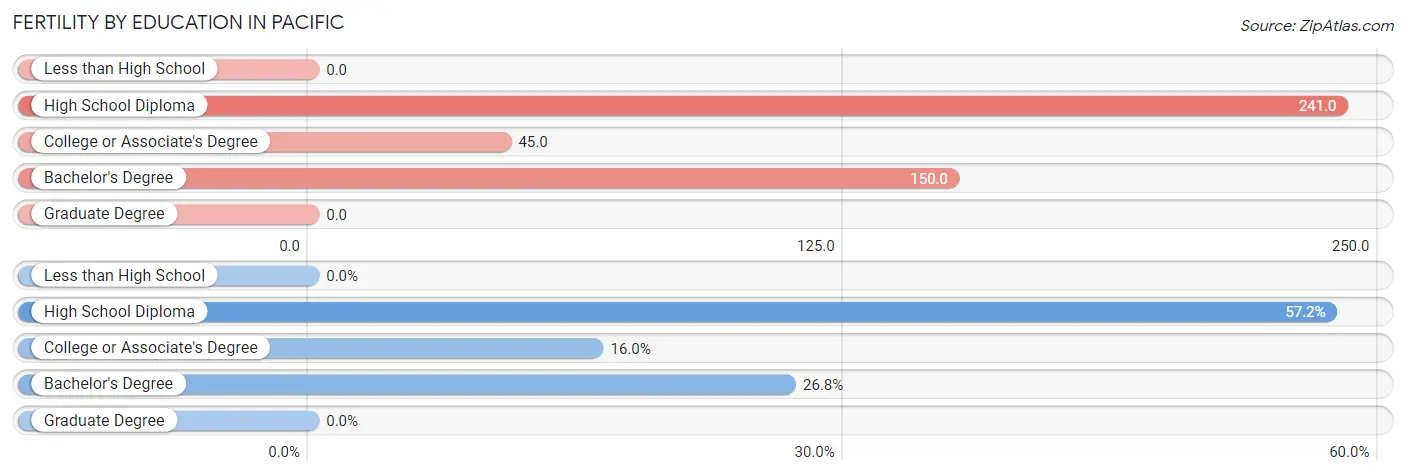
| Educational Attainment | Women with Births | Births / 1,000 Women |
| Less than High School | 0 (0.0%) | 0.0 |
| High School Diploma | 111 (57.2%) | 241.0 |
| College or Associate's Degree | 31 (16.0%) | 45.0 |
| Bachelor's Degree | 52 (26.8%) | 150.0 |
| Graduate Degree | 0 (0.0%) | 0.0 |
| Total | 194 (100.0%) | 114.0 |
Fertility by Education by Marriage Status in Pacific
16.0% of women with births in Pacific are unmarried. Women with the educational attainment of high school diploma are most likely to be married with 100.0% of them married at childbirth, while women with the educational attainment of college or associate's degree are least likely to be married with 100.0% of them unmarried at childbirth.

| Educational Attainment | Married | Unmarried |
| Less than High School | 0 (0.0%) | 0 (0.0%) |
| High School Diploma | 111 (100.0%) | 0 (0.0%) |
| College or Associate's Degree | 0 (0.0%) | 31 (100.0%) |
| Bachelor's Degree | 52 (100.0%) | 0 (0.0%) |
| Graduate Degree | 0 (0.0%) | 0 (0.0%) |
| Total | 163 (84.0%) | 31 (16.0%) |
Employment Characteristics in Pacific
Employment by Class of Employer in Pacific
Among the 3,549 employed individuals in Pacific, private company employees (2,541 | 71.6%), self-employed (not incorporated) (354 | 10.0%), and local government employees (248 | 7.0%) make up the most common classes of employment.

| Employer Class | # Employees | % Employees |
| Private Company Employees | 2,541 | 71.6% |
| Self-Employed (Incorporated) | 33 | 0.9% |
| Self-Employed (Not Incorporated) | 354 | 10.0% |
| Not-for-profit Organizations | 208 | 5.9% |
| Local Government Employees | 248 | 7.0% |
| State Government Employees | 44 | 1.2% |
| Federal Government Employees | 121 | 3.4% |
| Unpaid Family Workers | 0 | 0.0% |
| Total | 3,549 | 100.0% |
Employment Status by Age in Pacific
According to the labor force statistics for Pacific, out of the total population over 16 years of age (6,225), 58.8% or 3,660 individuals are in the labor force, with 1.5% or 55 of them unemployed. The age group with the highest labor force participation rate is 16 to 19 years, with 85.8% or 272 individuals in the labor force. Within the labor force, the 30 to 34 years age range has the highest percentage of unemployed individuals, with 7.8% or 31 of them being unemployed.

| Age Bracket | In Labor Force | Unemployed |
| 16 to 19 Years | 272 (85.8%) | 0 (0.0%) |
| 20 to 24 Years | 435 (73.6%) | 0 (0.0%) |
| 25 to 29 Years | 416 (72.3%) | 23 (5.5%) |
| 30 to 34 Years | 396 (57.1%) | 31 (7.8%) |
| 35 to 44 Years | 723 (71.7%) | 0 (0.0%) |
| 45 to 54 Years | 606 (68.2%) | 0 (0.0%) |
| 55 to 59 Years | 224 (64.6%) | 0 (0.0%) |
| 60 to 64 Years | 431 (68.7%) | 0 (0.0%) |
| 65 to 74 Years | 155 (28.9%) | 0 (0.0%) |
| 75 Years and over | 0 (0.0%) | 0 (0.0%) |
| Total | 3,660 (58.8%) | 55 (1.5%) |
Employment Status by Educational Attainment in Pacific
According to labor force statistics for Pacific, 67.6% of individuals (2,798) out of the total population between 25 and 64 years of age (4,139) are in the labor force, with 1.9% or 53 of them being unemployed. The group with the highest labor force participation rate are those with the educational attainment of bachelor's degree or higher, with 94.7% or 595 individuals in the labor force. Within the labor force, individuals with college / associate degree education have the highest percentage of unemployment, with 4.6% or 53 of them being unemployed.

| Educational Attainment | In Labor Force | Unemployed |
| Less than High School | 185 (52.6%) | 0 (0.0%) |
| High School Diploma | 854 (54.2%) | 0 (0.0%) |
| College / Associate Degree | 1,163 (73.4%) | 73 (4.6%) |
| Bachelor's Degree or higher | 595 (94.7%) | 0 (0.0%) |
| Total | 2,798 (67.6%) | 79 (1.9%) |
Employment Occupations by Sex in Pacific
Management, Business, Science and Arts Occupations
The most common Management, Business, Science and Arts occupations in Pacific are Management (512 | 14.2%), Community & Social Service (244 | 6.8%), Computers, Engineering & Science (198 | 5.5%), Education Instruction & Library (198 | 5.5%), and Computers & Mathematics (133 | 3.7%).
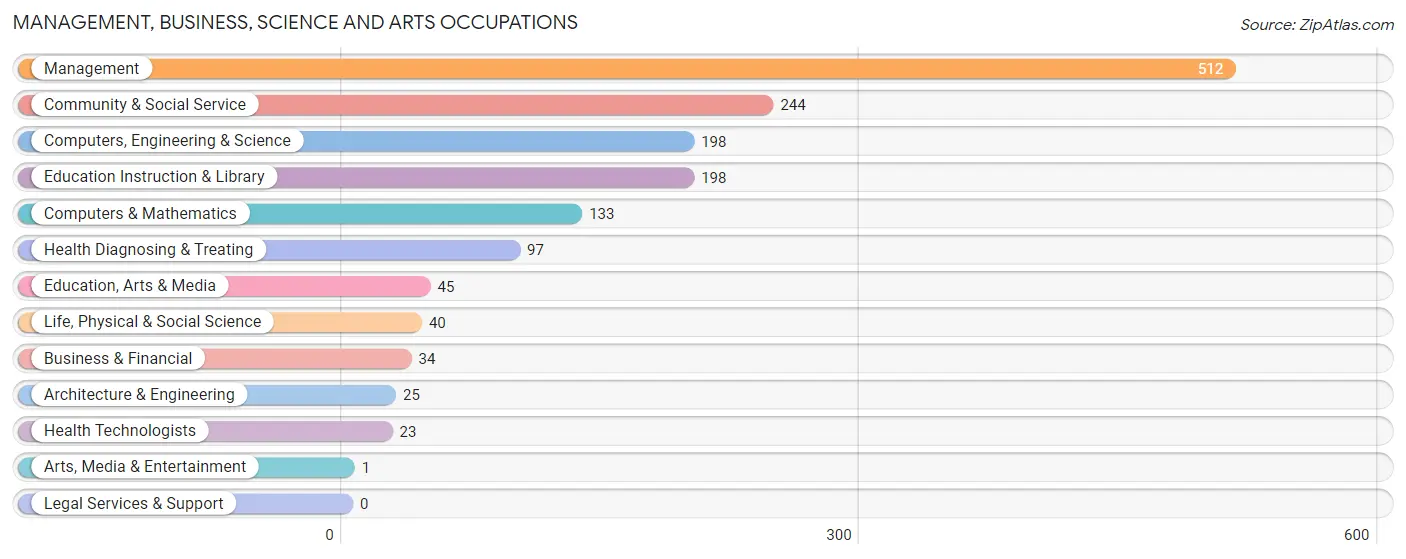
Management, Business, Science and Arts Occupations by Sex
Within the Management, Business, Science and Arts occupations in Pacific, the most male-oriented occupations are Education, Arts & Media (100.0%), Computers & Mathematics (80.4%), and Business & Financial (64.7%), while the most female-oriented occupations are Architecture & Engineering (100.0%), Arts, Media & Entertainment (100.0%), and Health Diagnosing & Treating (100.0%).
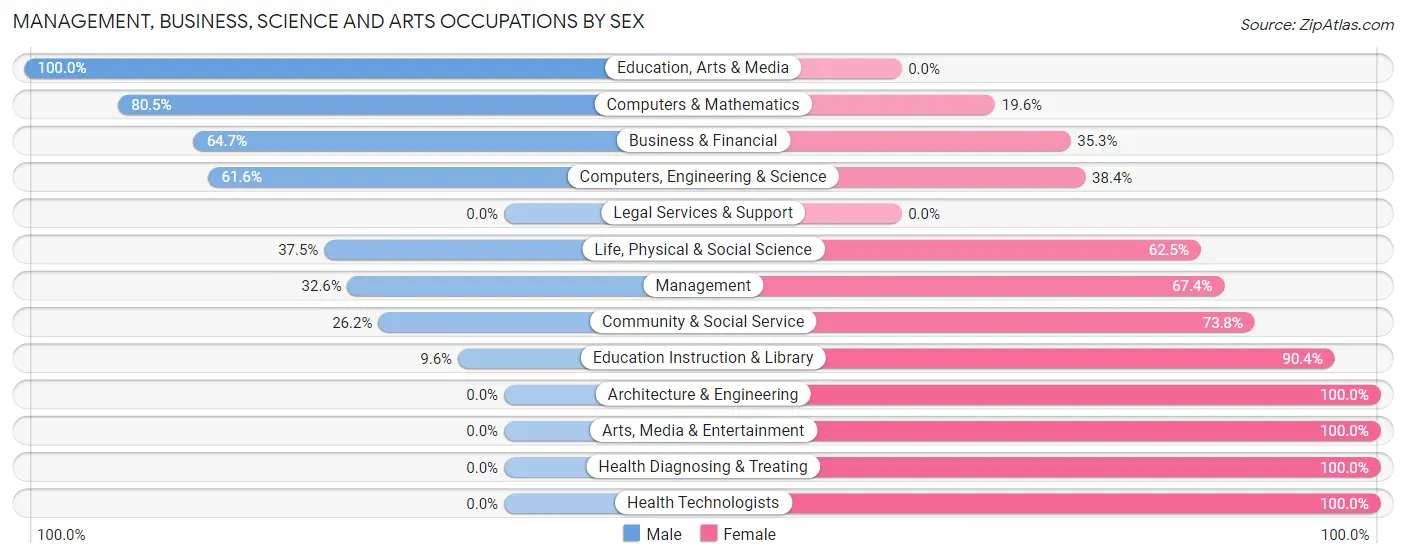
| Occupation | Male | Female |
| Management | 167 (32.6%) | 345 (67.4%) |
| Business & Financial | 22 (64.7%) | 12 (35.3%) |
| Computers, Engineering & Science | 122 (61.6%) | 76 (38.4%) |
| Computers & Mathematics | 107 (80.4%) | 26 (19.6%) |
| Architecture & Engineering | 0 (0.0%) | 25 (100.0%) |
| Life, Physical & Social Science | 15 (37.5%) | 25 (62.5%) |
| Community & Social Service | 64 (26.2%) | 180 (73.8%) |
| Education, Arts & Media | 45 (100.0%) | 0 (0.0%) |
| Legal Services & Support | 0 (0.0%) | 0 (0.0%) |
| Education Instruction & Library | 19 (9.6%) | 179 (90.4%) |
| Arts, Media & Entertainment | 0 (0.0%) | 1 (100.0%) |
| Health Diagnosing & Treating | 0 (0.0%) | 97 (100.0%) |
| Health Technologists | 0 (0.0%) | 23 (100.0%) |
| Total (Category) | 375 (34.6%) | 710 (65.4%) |
| Total (Overall) | 1,780 (49.4%) | 1,824 (50.6%) |
Services Occupations
The most common Services occupations in Pacific are Food Preparation & Serving (164 | 4.5%), Personal Care & Service (86 | 2.4%), Healthcare Support (61 | 1.7%), Cleaning & Maintenance (37 | 1.0%), and Security & Protection (23 | 0.6%).

Services Occupations by Sex
Within the Services occupations in Pacific, the most male-oriented occupations are Security & Protection (100.0%), Firefighting & Prevention (100.0%), and Cleaning & Maintenance (67.6%), while the most female-oriented occupations are Food Preparation & Serving (79.3%), Personal Care & Service (70.9%), and Healthcare Support (62.3%).

| Occupation | Male | Female |
| Healthcare Support | 23 (37.7%) | 38 (62.3%) |
| Security & Protection | 23 (100.0%) | 0 (0.0%) |
| Firefighting & Prevention | 23 (100.0%) | 0 (0.0%) |
| Law Enforcement | 0 (0.0%) | 0 (0.0%) |
| Food Preparation & Serving | 34 (20.7%) | 130 (79.3%) |
| Cleaning & Maintenance | 25 (67.6%) | 12 (32.4%) |
| Personal Care & Service | 25 (29.1%) | 61 (70.9%) |
| Total (Category) | 130 (35.0%) | 241 (65.0%) |
| Total (Overall) | 1,780 (49.4%) | 1,824 (50.6%) |
Sales and Office Occupations
The most common Sales and Office occupations in Pacific are Office & Administration (727 | 20.2%), and Sales & Related (272 | 7.5%).

Sales and Office Occupations by Sex

| Occupation | Male | Female |
| Sales & Related | 176 (64.7%) | 96 (35.3%) |
| Office & Administration | 104 (14.3%) | 623 (85.7%) |
| Total (Category) | 280 (28.0%) | 719 (72.0%) |
| Total (Overall) | 1,780 (49.4%) | 1,824 (50.6%) |
Natural Resources, Construction and Maintenance Occupations
The most common Natural Resources, Construction and Maintenance occupations in Pacific are Construction & Extraction (549 | 15.2%), and Installation, Maintenance & Repair (167 | 4.6%).

Natural Resources, Construction and Maintenance Occupations by Sex

| Occupation | Male | Female |
| Farming, Fishing & Forestry | 0 (0.0%) | 0 (0.0%) |
| Construction & Extraction | 516 (94.0%) | 33 (6.0%) |
| Installation, Maintenance & Repair | 167 (100.0%) | 0 (0.0%) |
| Total (Category) | 683 (95.4%) | 33 (4.6%) |
| Total (Overall) | 1,780 (49.4%) | 1,824 (50.6%) |
Production, Transportation and Moving Occupations
The most common Production, Transportation and Moving occupations in Pacific are Production (265 | 7.3%), Material Moving (116 | 3.2%), and Transportation (52 | 1.4%).

Production, Transportation and Moving Occupations by Sex

| Occupation | Male | Female |
| Production | 185 (69.8%) | 80 (30.2%) |
| Transportation | 52 (100.0%) | 0 (0.0%) |
| Material Moving | 75 (64.7%) | 41 (35.3%) |
| Total (Category) | 312 (72.1%) | 121 (27.9%) |
| Total (Overall) | 1,780 (49.4%) | 1,824 (50.6%) |
Employment Industries by Sex in Pacific
Employment Industries in Pacific
The major employment industries in Pacific include Retail Trade (643 | 17.8%), Construction (583 | 16.2%), Manufacturing (470 | 13.0%), Educational Services (264 | 7.3%), and Accommodation & Food Services (225 | 6.2%).
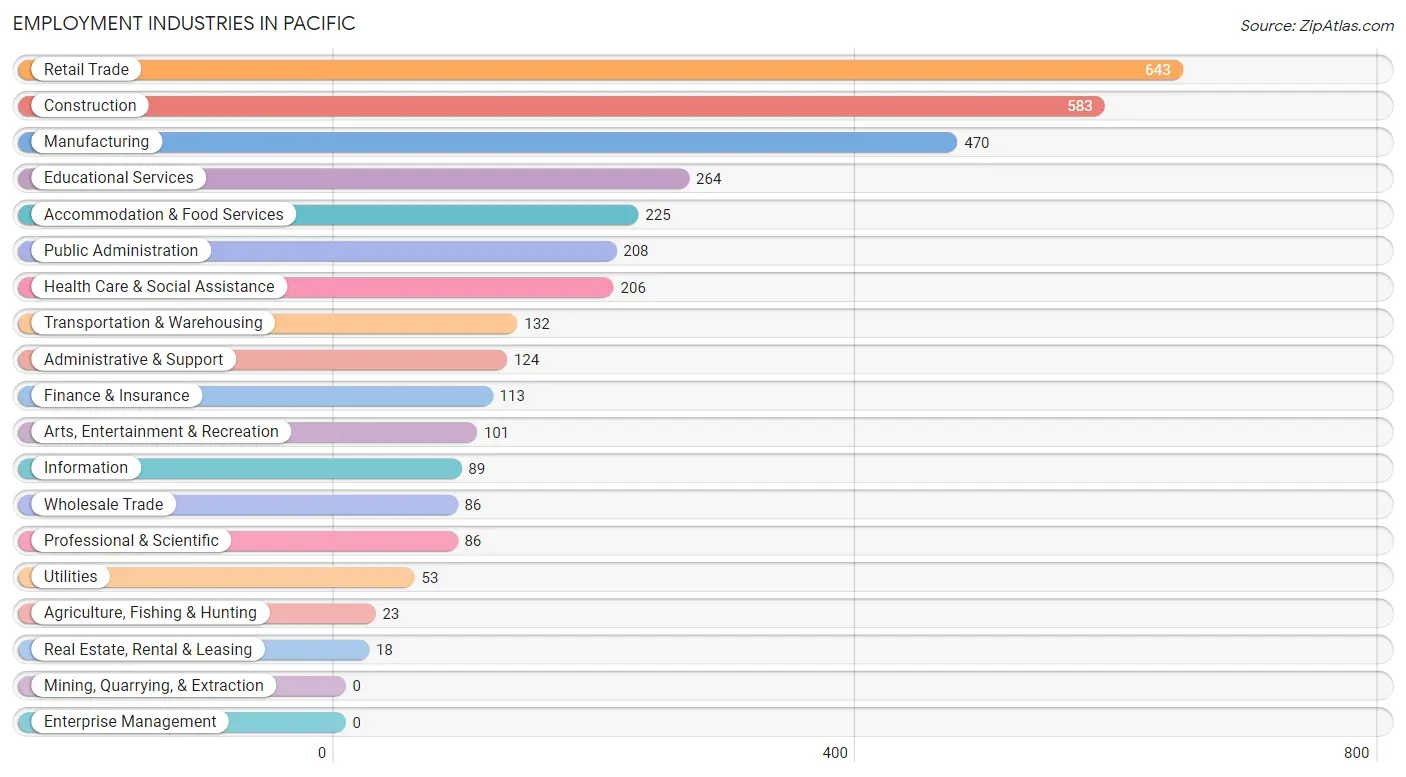
Employment Industries by Sex in Pacific
The Pacific industries that see more men than women are Information (100.0%), Real Estate, Rental & Leasing (100.0%), and Construction (88.2%), whereas the industries that tend to have a higher number of women are Agriculture, Fishing & Hunting (100.0%), Health Care & Social Assistance (92.7%), and Educational Services (89.0%).
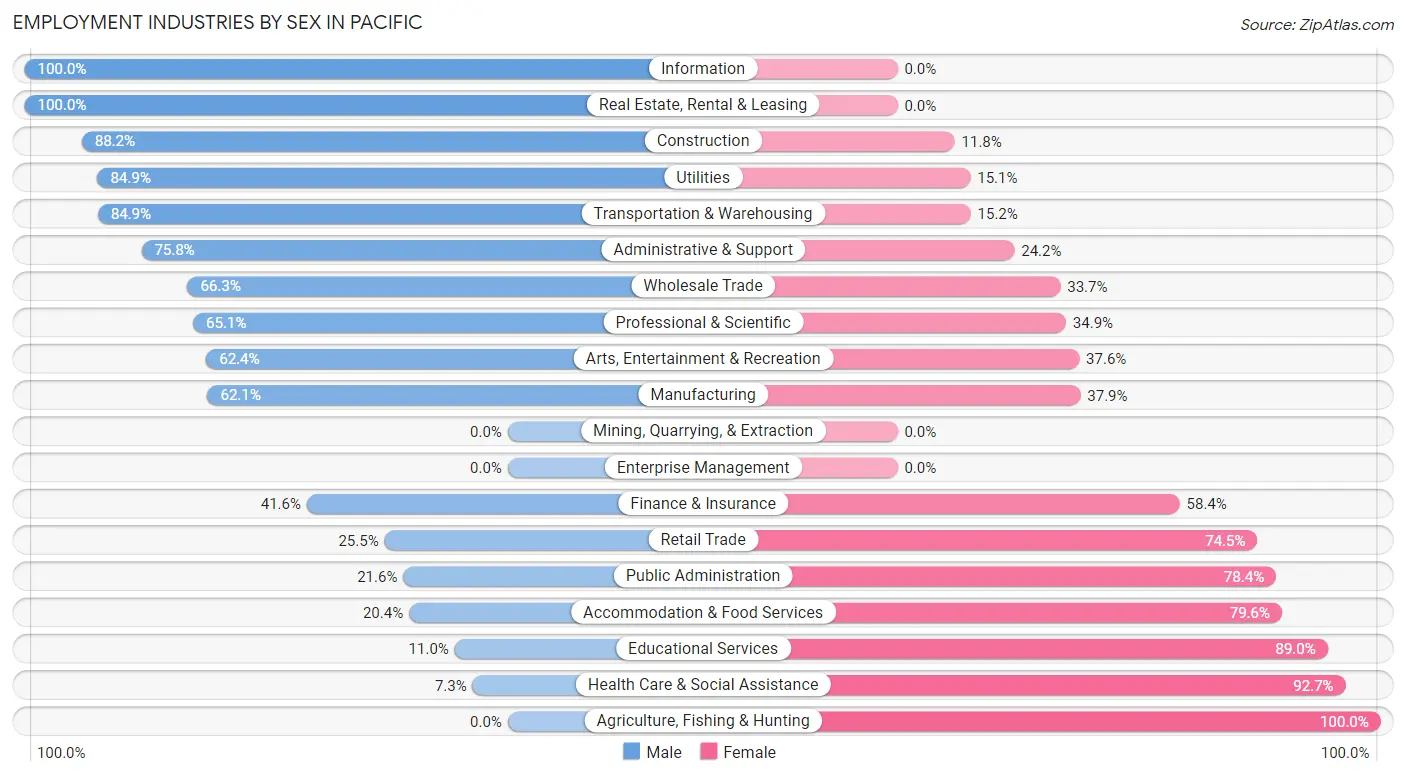
| Industry | Male | Female |
| Agriculture, Fishing & Hunting | 0 (0.0%) | 23 (100.0%) |
| Mining, Quarrying, & Extraction | 0 (0.0%) | 0 (0.0%) |
| Construction | 514 (88.2%) | 69 (11.8%) |
| Manufacturing | 292 (62.1%) | 178 (37.9%) |
| Wholesale Trade | 57 (66.3%) | 29 (33.7%) |
| Retail Trade | 164 (25.5%) | 479 (74.5%) |
| Transportation & Warehousing | 112 (84.9%) | 20 (15.1%) |
| Utilities | 45 (84.9%) | 8 (15.1%) |
| Information | 89 (100.0%) | 0 (0.0%) |
| Finance & Insurance | 47 (41.6%) | 66 (58.4%) |
| Real Estate, Rental & Leasing | 18 (100.0%) | 0 (0.0%) |
| Professional & Scientific | 56 (65.1%) | 30 (34.9%) |
| Enterprise Management | 0 (0.0%) | 0 (0.0%) |
| Administrative & Support | 94 (75.8%) | 30 (24.2%) |
| Educational Services | 29 (11.0%) | 235 (89.0%) |
| Health Care & Social Assistance | 15 (7.3%) | 191 (92.7%) |
| Arts, Entertainment & Recreation | 63 (62.4%) | 38 (37.6%) |
| Accommodation & Food Services | 46 (20.4%) | 179 (79.6%) |
| Public Administration | 45 (21.6%) | 163 (78.4%) |
| Total | 1,780 (49.4%) | 1,824 (50.6%) |
Education in Pacific
School Enrollment in Pacific
The most common levels of schooling among the 1,073 students in Pacific are middle school (329 | 30.7%), college / undergraduate (271 | 25.3%), and high school (181 | 16.9%).

| School Level | # Students | % Students |
| Nursery / Preschool | 52 | 4.9% |
| Kindergarten | 72 | 6.7% |
| Elementary School | 160 | 14.9% |
| Middle School | 329 | 30.7% |
| High School | 181 | 16.9% |
| College / Undergraduate | 271 | 25.3% |
| Graduate / Professional | 8 | 0.7% |
| Total | 1,073 | 100.0% |
School Enrollment by Age by Funding Source in Pacific
Out of a total of 1,073 students who are enrolled in schools in Pacific, 63 (5.9%) attend a private institution, while the remaining 1,010 (94.1%) are enrolled in public schools. The age group of 3 to 4 year olds has the highest likelihood of being enrolled in private schools, with 17 (73.9% in the age bracket) enrolled. Conversely, the age group of 5 to 9 year old has the lowest likelihood of being enrolled in a private school, with 261 (100.0% in the age bracket) attending a public institution.

| Age Bracket | Public School | Private School |
| 3 to 4 Year Olds | 6 (26.1%) | 17 (73.9%) |
| 5 to 9 Year Old | 261 (100.0%) | 0 (0.0%) |
| 10 to 14 Year Olds | 331 (94.6%) | 19 (5.4%) |
| 15 to 17 Year Olds | 124 (100.0%) | 0 (0.0%) |
| 18 to 19 Year Olds | 55 (100.0%) | 0 (0.0%) |
| 20 to 24 Year Olds | 102 (80.3%) | 25 (19.7%) |
| 25 to 34 Year Olds | 70 (97.2%) | 2 (2.8%) |
| 35 Years and over | 61 (100.0%) | 0 (0.0%) |
| Total | 1,010 (94.1%) | 63 (5.9%) |
Educational Attainment by Field of Study in Pacific
Education (175 | 18.2%), business (143 | 14.9%), bio, nature & agricultural (138 | 14.4%), arts & humanities (100 | 10.4%), and science & technology (99 | 10.3%) are the most common fields of study among 960 individuals in Pacific who have obtained a bachelor's degree or higher.
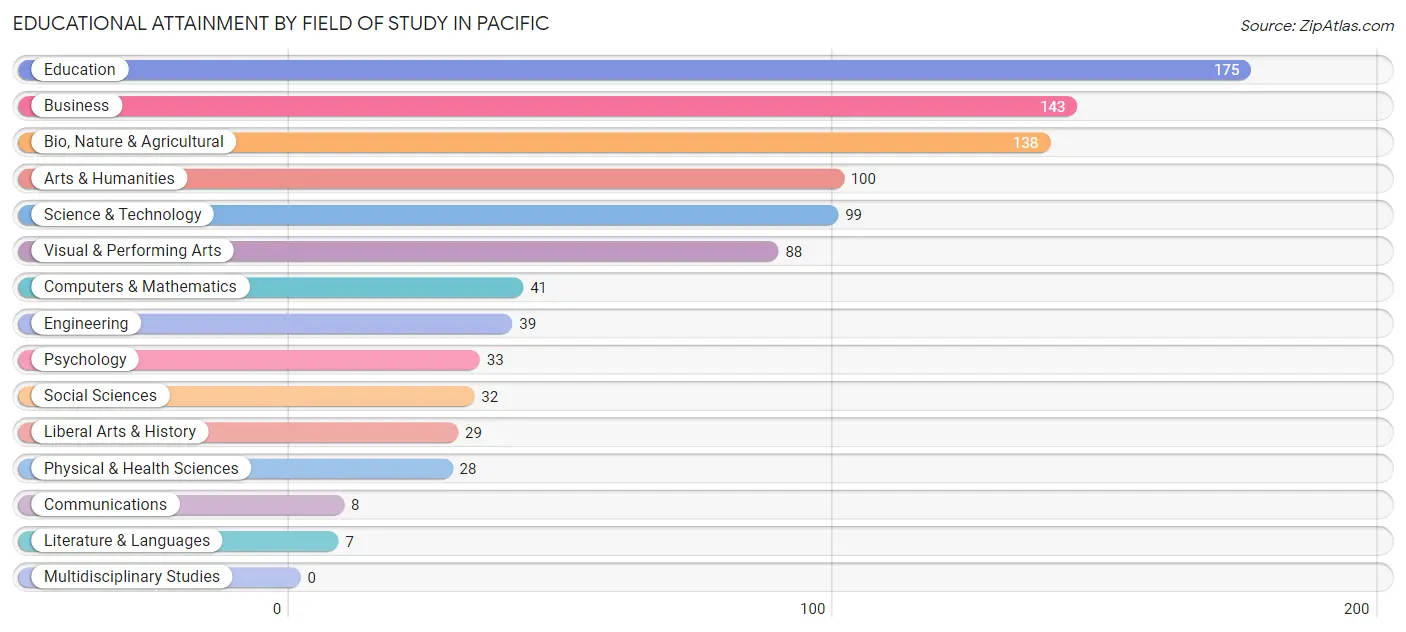
| Field of Study | # Graduates | % Graduates |
| Computers & Mathematics | 41 | 4.3% |
| Bio, Nature & Agricultural | 138 | 14.4% |
| Physical & Health Sciences | 28 | 2.9% |
| Psychology | 33 | 3.4% |
| Social Sciences | 32 | 3.3% |
| Engineering | 39 | 4.1% |
| Multidisciplinary Studies | 0 | 0.0% |
| Science & Technology | 99 | 10.3% |
| Business | 143 | 14.9% |
| Education | 175 | 18.2% |
| Literature & Languages | 7 | 0.7% |
| Liberal Arts & History | 29 | 3.0% |
| Visual & Performing Arts | 88 | 9.2% |
| Communications | 8 | 0.8% |
| Arts & Humanities | 100 | 10.4% |
| Total | 960 | 100.0% |
Transportation & Commute in Pacific
Vehicle Availability by Sex in Pacific
The most prevalent vehicle ownership categories in Pacific are males with 2 vehicles (791, accounting for 45.3%) and females with 2 vehicles (600, making up 43.9%).

| Vehicles Available | Male | Female |
| No Vehicle | 39 (2.2%) | 49 (2.7%) |
| 1 Vehicle | 346 (19.8%) | 444 (24.6%) |
| 2 Vehicles | 791 (45.3%) | 600 (33.3%) |
| 3 Vehicles | 346 (19.8%) | 390 (21.6%) |
| 4 Vehicles | 95 (5.4%) | 160 (8.9%) |
| 5 or more Vehicles | 130 (7.4%) | 158 (8.8%) |
| Total | 1,747 (100.0%) | 1,801 (100.0%) |
Commute Time in Pacific
The most frequently occuring commute durations in Pacific are 45 to 59 minutes (627 commuters, 18.9%), 30 to 34 minutes (593 commuters, 17.9%), and 25 to 29 minutes (408 commuters, 12.3%).
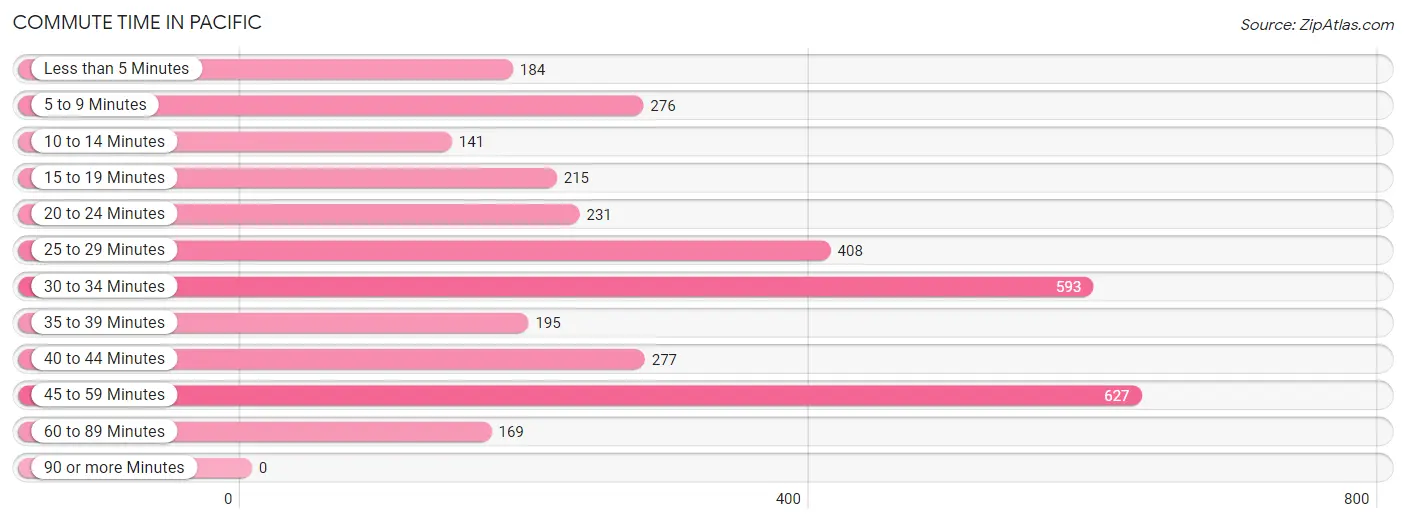
| Commute Time | # Commuters | % Commuters |
| Less than 5 Minutes | 184 | 5.6% |
| 5 to 9 Minutes | 276 | 8.3% |
| 10 to 14 Minutes | 141 | 4.3% |
| 15 to 19 Minutes | 215 | 6.5% |
| 20 to 24 Minutes | 231 | 7.0% |
| 25 to 29 Minutes | 408 | 12.3% |
| 30 to 34 Minutes | 593 | 17.9% |
| 35 to 39 Minutes | 195 | 5.9% |
| 40 to 44 Minutes | 277 | 8.4% |
| 45 to 59 Minutes | 627 | 18.9% |
| 60 to 89 Minutes | 169 | 5.1% |
| 90 or more Minutes | 0 | 0.0% |
Commute Time by Sex in Pacific
The most common commute times in Pacific are 45 to 59 minutes (475 commuters, 28.7%) for males and 30 to 34 minutes (457 commuters, 27.6%) for females.
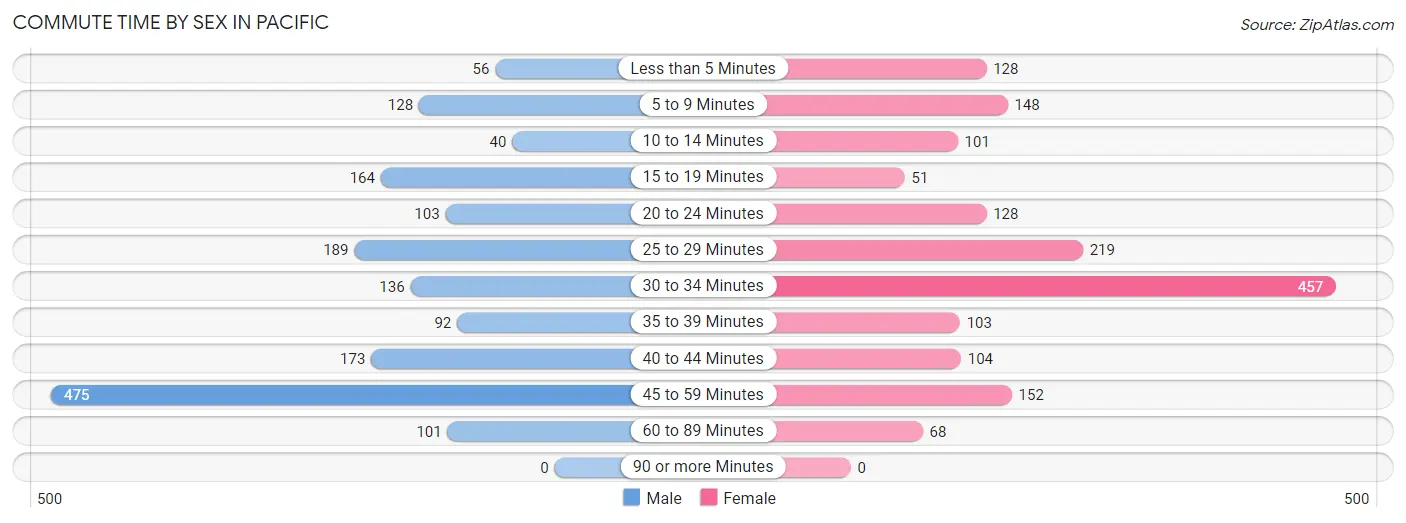
| Commute Time | Male | Female |
| Less than 5 Minutes | 56 (3.4%) | 128 (7.7%) |
| 5 to 9 Minutes | 128 (7.7%) | 148 (8.9%) |
| 10 to 14 Minutes | 40 (2.4%) | 101 (6.1%) |
| 15 to 19 Minutes | 164 (9.9%) | 51 (3.1%) |
| 20 to 24 Minutes | 103 (6.2%) | 128 (7.7%) |
| 25 to 29 Minutes | 189 (11.4%) | 219 (13.2%) |
| 30 to 34 Minutes | 136 (8.2%) | 457 (27.6%) |
| 35 to 39 Minutes | 92 (5.6%) | 103 (6.2%) |
| 40 to 44 Minutes | 173 (10.4%) | 104 (6.3%) |
| 45 to 59 Minutes | 475 (28.7%) | 152 (9.2%) |
| 60 to 89 Minutes | 101 (6.1%) | 68 (4.1%) |
| 90 or more Minutes | 0 (0.0%) | 0 (0.0%) |
Time of Departure to Work by Sex in Pacific
The most frequent times of departure to work in Pacific are 6:30 AM to 6:59 AM (349, 21.1%) for males and 12:00 PM to 3:59 PM (427, 25.7%) for females.
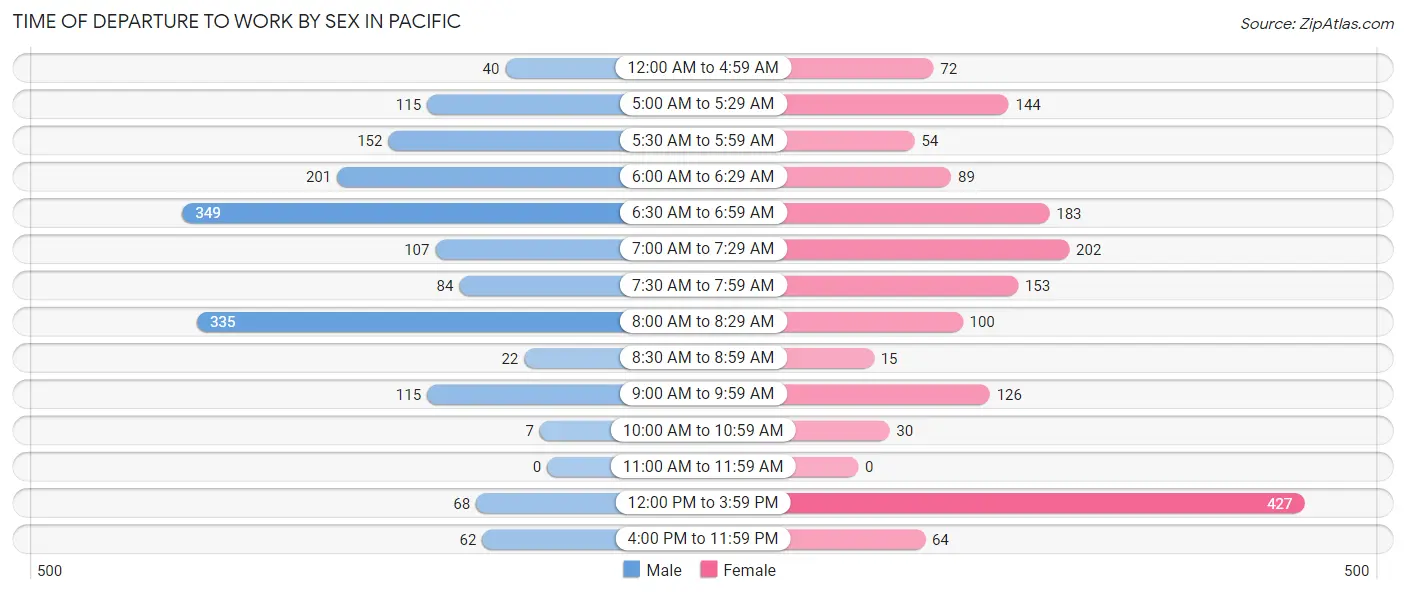
| Time of Departure | Male | Female |
| 12:00 AM to 4:59 AM | 40 (2.4%) | 72 (4.3%) |
| 5:00 AM to 5:29 AM | 115 (6.9%) | 144 (8.7%) |
| 5:30 AM to 5:59 AM | 152 (9.2%) | 54 (3.3%) |
| 6:00 AM to 6:29 AM | 201 (12.1%) | 89 (5.4%) |
| 6:30 AM to 6:59 AM | 349 (21.1%) | 183 (11.0%) |
| 7:00 AM to 7:29 AM | 107 (6.5%) | 202 (12.2%) |
| 7:30 AM to 7:59 AM | 84 (5.1%) | 153 (9.2%) |
| 8:00 AM to 8:29 AM | 335 (20.2%) | 100 (6.0%) |
| 8:30 AM to 8:59 AM | 22 (1.3%) | 15 (0.9%) |
| 9:00 AM to 9:59 AM | 115 (6.9%) | 126 (7.6%) |
| 10:00 AM to 10:59 AM | 7 (0.4%) | 30 (1.8%) |
| 11:00 AM to 11:59 AM | 0 (0.0%) | 0 (0.0%) |
| 12:00 PM to 3:59 PM | 68 (4.1%) | 427 (25.7%) |
| 4:00 PM to 11:59 PM | 62 (3.7%) | 64 (3.9%) |
| Total | 1,657 (100.0%) | 1,659 (100.0%) |
Housing Occupancy in Pacific
Occupancy by Ownership in Pacific
Of the total 3,115 dwellings in Pacific, owner-occupied units account for 1,844 (59.2%), while renter-occupied units make up 1,271 (40.8%).

| Occupancy | # Housing Units | % Housing Units |
| Owner Occupied Housing Units | 1,844 | 59.2% |
| Renter-Occupied Housing Units | 1,271 | 40.8% |
| Total Occupied Housing Units | 3,115 | 100.0% |
Occupancy by Household Size in Pacific

| Household Size | # Housing Units | % Housing Units |
| 1-Person Household | 1,398 | 44.9% |
| 2-Person Household | 826 | 26.5% |
| 3-Person Household | 586 | 18.8% |
| 4+ Person Household | 305 | 9.8% |
| Total Housing Units | 3,115 | 100.0% |
Occupancy by Ownership by Household Size in Pacific

| Household Size | Owner-occupied | Renter-occupied |
| 1-Person Household | 580 (41.5%) | 818 (58.5%) |
| 2-Person Household | 530 (64.2%) | 296 (35.8%) |
| 3-Person Household | 435 (74.2%) | 151 (25.8%) |
| 4+ Person Household | 299 (98.0%) | 6 (2.0%) |
| Total Housing Units | 1,844 (59.2%) | 1,271 (40.8%) |
Occupancy by Educational Attainment in Pacific

| Household Size | Owner-occupied | Renter-occupied |
| Less than High School | 166 (58.0%) | 120 (42.0%) |
| High School Diploma | 429 (42.0%) | 592 (58.0%) |
| College/Associate Degree | 765 (61.3%) | 483 (38.7%) |
| Bachelor's Degree or higher | 484 (86.4%) | 76 (13.6%) |
Occupancy by Age of Householder in Pacific

| Age Bracket | # Households | % Households |
| Under 35 Years | 740 | 23.8% |
| 35 to 44 Years | 506 | 16.2% |
| 45 to 54 Years | 485 | 15.6% |
| 55 to 64 Years | 552 | 17.7% |
| 65 to 74 Years | 421 | 13.5% |
| 75 to 84 Years | 298 | 9.6% |
| 85 Years and Over | 113 | 3.6% |
| Total | 3,115 | 100.0% |
Housing Finances in Pacific
Median Income by Occupancy in Pacific

| Occupancy Type | # Households | Median Income |
| Owner-Occupied | 1,844 (59.2%) | $67,083 |
| Renter-Occupied | 1,271 (40.8%) | $30,898 |
| Average | 3,115 (100.0%) | $52,155 |
Occupancy by Householder Income Bracket in Pacific
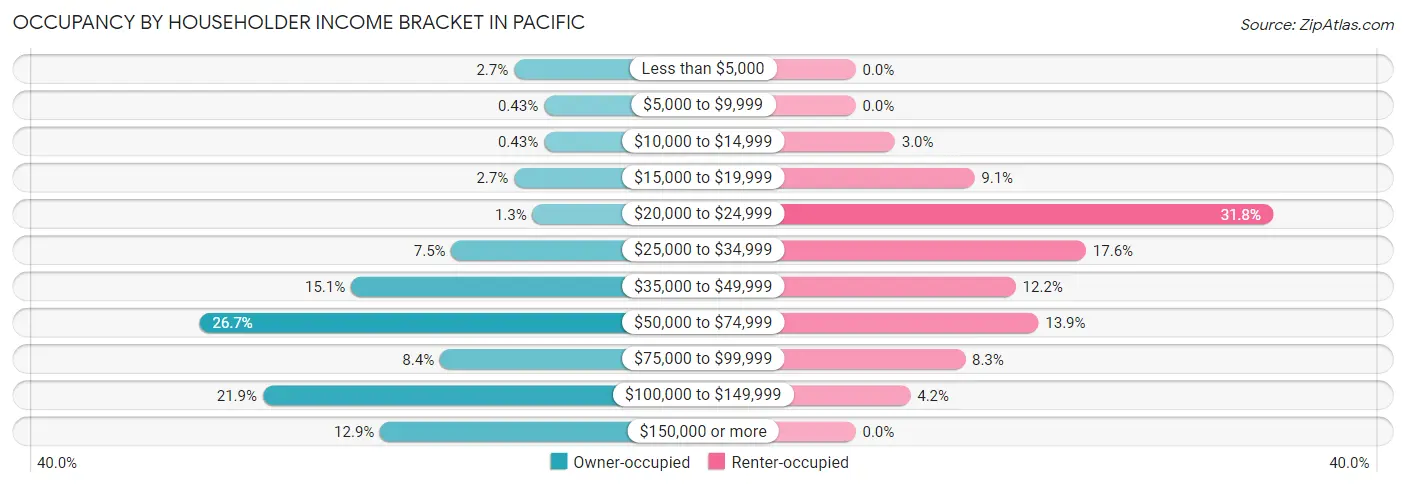
| Income Bracket | Owner-occupied | Renter-occupied |
| Less than $5,000 | 50 (2.7%) | 0 (0.0%) |
| $5,000 to $9,999 | 8 (0.4%) | 0 (0.0%) |
| $10,000 to $14,999 | 8 (0.4%) | 38 (3.0%) |
| $15,000 to $19,999 | 50 (2.7%) | 115 (9.0%) |
| $20,000 to $24,999 | 24 (1.3%) | 404 (31.8%) |
| $25,000 to $34,999 | 138 (7.5%) | 223 (17.5%) |
| $35,000 to $49,999 | 279 (15.1%) | 155 (12.2%) |
| $50,000 to $74,999 | 492 (26.7%) | 177 (13.9%) |
| $75,000 to $99,999 | 154 (8.4%) | 106 (8.3%) |
| $100,000 to $149,999 | 403 (21.8%) | 53 (4.2%) |
| $150,000 or more | 238 (12.9%) | 0 (0.0%) |
| Total | 1,844 (100.0%) | 1,271 (100.0%) |
Monthly Housing Cost Tiers in Pacific

| Monthly Cost | Owner-occupied | Renter-occupied |
| Less than $300 | 56 (3.0%) | 12 (0.9%) |
| $300 to $499 | 193 (10.5%) | 0 (0.0%) |
| $500 to $799 | 291 (15.8%) | 535 (42.1%) |
| $800 to $999 | 105 (5.7%) | 524 (41.2%) |
| $1,000 to $1,499 | 531 (28.8%) | 121 (9.5%) |
| $1,500 to $1,999 | 488 (26.5%) | 0 (0.0%) |
| $2,000 to $2,499 | 115 (6.2%) | 23 (1.8%) |
| $2,500 to $2,999 | 42 (2.3%) | 0 (0.0%) |
| $3,000 or more | 23 (1.3%) | 0 (0.0%) |
| Total | 1,844 (100.0%) | 1,271 (100.0%) |
Physical Housing Characteristics in Pacific
Housing Structures in Pacific

| Structure Type | # Housing Units | % Housing Units |
| Single Unit, Detached | 1,855 | 59.6% |
| Single Unit, Attached | 181 | 5.8% |
| 2 Unit Apartments | 222 | 7.1% |
| 3 or 4 Unit Apartments | 131 | 4.2% |
| 5 to 9 Unit Apartments | 201 | 6.5% |
| 10 or more Apartments | 427 | 13.7% |
| Mobile Home / Other | 98 | 3.2% |
| Total | 3,115 | 100.0% |
Housing Structures by Occupancy in Pacific

| Structure Type | Owner-occupied | Renter-occupied |
| Single Unit, Detached | 1,726 (93.0%) | 129 (7.0%) |
| Single Unit, Attached | 36 (19.9%) | 145 (80.1%) |
| 2 Unit Apartments | 0 (0.0%) | 222 (100.0%) |
| 3 or 4 Unit Apartments | 0 (0.0%) | 131 (100.0%) |
| 5 to 9 Unit Apartments | 21 (10.4%) | 180 (89.5%) |
| 10 or more Apartments | 19 (4.4%) | 408 (95.6%) |
| Mobile Home / Other | 42 (42.9%) | 56 (57.1%) |
| Total | 1,844 (59.2%) | 1,271 (40.8%) |
Housing Structures by Number of Rooms in Pacific

| Number of Rooms | Owner-occupied | Renter-occupied |
| 1 Room | 0 (0.0%) | 0 (0.0%) |
| 2 or 3 Rooms | 45 (2.4%) | 176 (13.9%) |
| 4 or 5 Rooms | 594 (32.2%) | 989 (77.8%) |
| 6 or 7 Rooms | 671 (36.4%) | 80 (6.3%) |
| 8 or more Rooms | 534 (29.0%) | 26 (2.1%) |
| Total | 1,844 (100.0%) | 1,271 (100.0%) |
Housing Structure by Heating Type in Pacific

| Heating Type | Owner-occupied | Renter-occupied |
| Utility Gas | 880 (47.7%) | 276 (21.7%) |
| Bottled, Tank, or LP Gas | 65 (3.5%) | 9 (0.7%) |
| Electricity | 860 (46.6%) | 986 (77.6%) |
| Fuel Oil or Kerosene | 0 (0.0%) | 0 (0.0%) |
| Coal or Coke | 0 (0.0%) | 0 (0.0%) |
| All other Fuels | 16 (0.9%) | 0 (0.0%) |
| No Fuel Used | 23 (1.3%) | 0 (0.0%) |
| Total | 1,844 (100.0%) | 1,271 (100.0%) |
Household Vehicle Usage in Pacific

| Vehicles per Household | Owner-occupied | Renter-occupied |
| No Vehicle | 74 (4.0%) | 62 (4.9%) |
| 1 Vehicle | 603 (32.7%) | 728 (57.3%) |
| 2 Vehicles | 734 (39.8%) | 333 (26.2%) |
| 3 or more Vehicles | 433 (23.5%) | 148 (11.6%) |
| Total | 1,844 (100.0%) | 1,271 (100.0%) |
Real Estate & Mortgages in Pacific
Real Estate and Mortgage Overview in Pacific
| Characteristic | Without Mortgage | With Mortgage |
| Housing Units | 518 | 1,326 |
| Median Property Value | $244,600 | $223,600 |
| Median Household Income | $63,000 | $178 |
| Monthly Housing Costs | $517 | $23 |
| Real Estate Taxes | $2,244 | $0 |
Property Value by Mortgage Status in Pacific

| Property Value | Without Mortgage | With Mortgage |
| Less than $50,000 | 17 (3.3%) | 10 (0.7%) |
| $50,000 to $99,999 | 24 (4.6%) | 147 (11.1%) |
| $100,000 to $299,999 | 363 (70.1%) | 910 (68.6%) |
| $300,000 to $499,999 | 91 (17.6%) | 236 (17.8%) |
| $500,000 to $749,999 | 0 (0.0%) | 13 (1.0%) |
| $750,000 to $999,999 | 0 (0.0%) | 10 (0.7%) |
| $1,000,000 or more | 23 (4.4%) | 0 (0.0%) |
| Total | 518 (100.0%) | 1,326 (100.0%) |
Household Income by Mortgage Status in Pacific

| Household Income | Without Mortgage | With Mortgage |
| Less than $10,000 | 24 (4.6%) | 29 (2.2%) |
| $10,000 to $24,999 | 27 (5.2%) | 34 (2.6%) |
| $25,000 to $34,999 | 23 (4.4%) | 55 (4.2%) |
| $35,000 to $49,999 | 157 (30.3%) | 115 (8.7%) |
| $50,000 to $74,999 | 133 (25.7%) | 122 (9.2%) |
| $75,000 to $99,999 | 18 (3.5%) | 359 (27.1%) |
| $100,000 to $149,999 | 76 (14.7%) | 136 (10.3%) |
| $150,000 or more | 60 (11.6%) | 327 (24.7%) |
| Total | 518 (100.0%) | 1,326 (100.0%) |
Property Value to Household Income Ratio in Pacific

| Value-to-Income Ratio | Without Mortgage | With Mortgage |
| Less than 2.0x | 106 (20.5%) | 69,952 (5,275.4%) |
| 2.0x to 2.9x | 108 (20.8%) | 474 (35.7%) |
| 3.0x to 3.9x | 31 (6.0%) | 311 (23.4%) |
| 4.0x or more | 249 (48.1%) | 119 (9.0%) |
| Total | 518 (100.0%) | 1,326 (100.0%) |
Real Estate Taxes by Mortgage Status in Pacific

| Property Taxes | Without Mortgage | With Mortgage |
| Less than $800 | 40 (7.7%) | 0 (0.0%) |
| $800 to $1,499 | 83 (16.0%) | 151 (11.4%) |
| $800 to $1,499 | 395 (76.2%) | 201 (15.2%) |
| Total | 518 (100.0%) | 1,326 (100.0%) |
Health & Disability in Pacific
Health Insurance Coverage by Age in Pacific

| Age Bracket | With Coverage | Without Coverage |
| Under 6 Years | 464 (100.0%) | 0 (0.0%) |
| 6 to 18 Years | 829 (97.8%) | 19 (2.2%) |
| 19 to 25 Years | 594 (86.0%) | 97 (14.0%) |
| 26 to 34 Years | 678 (84.3%) | 126 (15.7%) |
| 35 to 44 Years | 773 (93.5%) | 54 (6.5%) |
| 45 to 54 Years | 557 (77.8%) | 159 (22.2%) |
| 55 to 64 Years | 665 (75.5%) | 216 (24.5%) |
| 65 to 74 Years | 508 (100.0%) | 0 (0.0%) |
| 75 Years and older | 597 (100.0%) | 0 (0.0%) |
| Total | 5,665 (89.4%) | 671 (10.6%) |
Health Insurance Coverage by Citizenship Status in Pacific

| Citizenship Status | With Coverage | Without Coverage |
| Native Born | 464 (100.0%) | 0 (0.0%) |
| Foreign Born, Citizen | 829 (97.8%) | 19 (2.2%) |
| Foreign Born, not a Citizen | 594 (86.0%) | 97 (14.0%) |
Health Insurance Coverage by Household Income in Pacific

| Household Income | With Coverage | Without Coverage |
| Under $25,000 | 561 (77.5%) | 163 (22.5%) |
| $25,000 to $49,999 | 1,059 (78.0%) | 299 (22.0%) |
| $50,000 to $74,999 | 1,203 (91.3%) | 115 (8.7%) |
| $75,000 to $99,999 | 647 (93.9%) | 42 (6.1%) |
| $100,000 and over | 2,193 (97.8%) | 49 (2.2%) |
Public vs Private Health Insurance Coverage by Age in Pacific

| Age Bracket | Public Insurance | Private Insurance |
| Under 6 | 87 (18.8%) | 398 (85.8%) |
| 6 to 18 Years | 92 (10.8%) | 745 (87.8%) |
| 19 to 25 Years | 37 (5.3%) | 594 (86.0%) |
| 25 to 34 Years | 59 (7.3%) | 667 (83.0%) |
| 35 to 44 Years | 84 (10.2%) | 715 (86.5%) |
| 45 to 54 Years | 60 (8.4%) | 533 (74.4%) |
| 55 to 64 Years | 167 (19.0%) | 542 (61.5%) |
| 65 to 74 Years | 488 (96.1%) | 253 (49.8%) |
| 75 Years and over | 597 (100.0%) | 258 (43.2%) |
| Total | 1,671 (26.4%) | 4,705 (74.3%) |
Disability Status by Sex by Age in Pacific

| Age Bracket | Male | Female |
| Under 5 Years | 0 (0.0%) | 0 (0.0%) |
| 5 to 17 Years | 15 (3.1%) | 0 (0.0%) |
| 18 to 34 Years | 0 (0.0%) | 52 (5.0%) |
| 35 to 64 Years | 103 (8.2%) | 246 (21.0%) |
| 65 to 74 Years | 92 (38.3%) | 69 (25.8%) |
| 75 Years and over | 113 (45.8%) | 225 (64.3%) |
Disability Class by Sex by Age in Pacific
Disability Class: Hearing Difficulty

| Age Bracket | Male | Female |
| Under 5 Years | 0 (0.0%) | 0 (0.0%) |
| 5 to 17 Years | 0 (0.0%) | 0 (0.0%) |
| 18 to 34 Years | 0 (0.0%) | 0 (0.0%) |
| 35 to 64 Years | 59 (4.7%) | 49 (4.2%) |
| 65 to 74 Years | 90 (37.5%) | 0 (0.0%) |
| 75 Years and over | 73 (29.5%) | 83 (23.7%) |
Disability Class: Vision Difficulty

| Age Bracket | Male | Female |
| Under 5 Years | 0 (0.0%) | 0 (0.0%) |
| 5 to 17 Years | 0 (0.0%) | 0 (0.0%) |
| 18 to 34 Years | 0 (0.0%) | 10 (1.0%) |
| 35 to 64 Years | 15 (1.2%) | 7 (0.6%) |
| 65 to 74 Years | 5 (2.1%) | 0 (0.0%) |
| 75 Years and over | 0 (0.0%) | 22 (6.3%) |
Disability Class: Cognitive Difficulty

| Age Bracket | Male | Female |
| 5 to 17 Years | 15 (3.1%) | 0 (0.0%) |
| 18 to 34 Years | 0 (0.0%) | 31 (3.0%) |
| 35 to 64 Years | 26 (2.1%) | 125 (10.7%) |
| 65 to 74 Years | 0 (0.0%) | 0 (0.0%) |
| 75 Years and over | 28 (11.3%) | 21 (6.0%) |
Disability Class: Ambulatory Difficulty

| Age Bracket | Male | Female |
| 5 to 17 Years | 0 (0.0%) | 0 (0.0%) |
| 18 to 34 Years | 0 (0.0%) | 11 (1.1%) |
| 35 to 64 Years | 18 (1.4%) | 161 (13.7%) |
| 65 to 74 Years | 67 (27.9%) | 69 (25.8%) |
| 75 Years and over | 111 (44.9%) | 171 (48.9%) |
Disability Class: Self-Care Difficulty

| Age Bracket | Male | Female |
| 5 to 17 Years | 0 (0.0%) | 0 (0.0%) |
| 18 to 34 Years | 0 (0.0%) | 0 (0.0%) |
| 35 to 64 Years | 0 (0.0%) | 70 (6.0%) |
| 65 to 74 Years | 0 (0.0%) | 0 (0.0%) |
| 75 Years and over | 45 (18.2%) | 25 (7.1%) |
Technology Access in Pacific
Computing Device Access in Pacific

| Device Type | # Households | % Households |
| Desktop or Laptop | 2,289 | 73.5% |
| Smartphone | 2,521 | 80.9% |
| Tablet | 1,593 | 51.1% |
| No Computing Device | 268 | 8.6% |
| Total | 3,115 | 100.0% |
Internet Access in Pacific

| Internet Type | # Households | % Households |
| Dial-Up Internet | 0 | 0.0% |
| Broadband Home | 2,337 | 75.0% |
| Cellular Data Only | 323 | 10.4% |
| Satellite Internet | 215 | 6.9% |
| No Internet | 276 | 8.9% |
| Total | 3,115 | 100.0% |
Pacific Summary
Pacific, Missouri is a city located in Franklin County, Missouri, United States. The population was 8,662 at the 2010 census. It is part of the St. Louis metropolitan area.
History
The area that is now Pacific was first settled in the early 1800s by German immigrants. The town was originally known as Franklin, but was renamed Pacific in 1872 when the Pacific Railroad was built through the area. The railroad was a major factor in the growth of the town, as it allowed for the transportation of goods and people.
The city was incorporated in 1876 and was home to a variety of businesses, including a flour mill, a brickyard, and a brewery. The city also had a number of churches, schools, and a library.
Geography
Pacific is located at 38°27′N 90°45′W (38.45, -90.75). According to the United States Census Bureau, the city has a total area of 4.2 square miles (10.8 km2), all land.
Economy
Pacific is home to a variety of businesses, including manufacturing, retail, and service industries. The city is also home to a number of restaurants, hotels, and other businesses.
The city is home to a number of large employers, including the Pacific School District, the Pacific Public Library, and the Pacific Fire Department.
Demographics
As of the 2010 census, there were 8,662 people, 3,521 households, and 2,323 families residing in the city. The population density was 2,062.2 people per square mile (797.2/km2). There were 3,845 housing units at an average density of 922.2 per square mile (355.7/km2). The racial makeup of the city was 92.2% White, 4.2% African American, 0.3% Native American, 0.7% Asian, 0.1% Pacific Islander, 0.7% from other races, and 1.9% from two or more races. Hispanic or Latino of any race were 2.2% of the population.
There were 3,521 households, out of which 32.2% had children under the age of 18 living with them, 48.2% were married couples living together, 13.2% had a female householder with no husband present, and 33.7% were non-families. 28.2% of all households were made up of individuals, and 11.3% had someone living alone who was 65 years of age or older. The average household size was 2.45 and the average family size was 3.00.
In the city, the population was spread out, with 25.2% under the age of 18, 8.2% from 18 to 24, 29.2% from 25 to 44, 22.3% from 45 to 64, and 15.1% who were 65 years of age or older. The median age was 36 years. For every 100 females, there were 93.2 males. For every 100 females age 18 and over, there were 89.3 males.
The median income for a household in the city was $41,944, and the median income for a family was $50,919. Males had a median income of $37,917 versus $27,917 for females. The per capita income for the city was $20,945. About 6.2% of families and 8.3% of the population were below the poverty line, including 10.2% of those under age 18 and 8.2% of those age 65 or over.
Common Questions
What is Per Capita Income in Pacific?
Per Capita income in Pacific is $30,527.
What is the Median Family Income in Pacific?
Median Family Income in Pacific is $86,042.
What is the Median Household income in Pacific?
Median Household Income in Pacific is $52,155.
What is Income or Wage Gap in Pacific?
Income or Wage Gap in Pacific is 32.7%.
Women in Pacific earn 67.3 cents for every dollar earned by a man.
What is Inequality or Gini Index in Pacific?
Inequality or Gini Index in Pacific is 0.42.
What is the Total Population of Pacific?
Total Population of Pacific is 7,239.
What is the Total Male Population of Pacific?
Total Male Population of Pacific is 3,979.
What is the Total Female Population of Pacific?
Total Female Population of Pacific is 3,260.
What is the Ratio of Males per 100 Females in Pacific?
There are 122.06 Males per 100 Females in Pacific.
What is the Ratio of Females per 100 Males in Pacific?
There are 81.93 Females per 100 Males in Pacific.
What is the Median Population Age in Pacific?
Median Population Age in Pacific is 39.6 Years.
What is the Average Family Size in Pacific
Average Family Size in Pacific is 2.9 People.
What is the Average Household Size in Pacific
Average Household Size in Pacific is 2.0 People.
How Large is the Labor Force in Pacific?
There are 3,660 People in the Labor Forcein in Pacific.
What is the Percentage of People in the Labor Force in Pacific?
58.8% of People are in the Labor Force in Pacific.
What is the Unemployment Rate in Pacific?
Unemployment Rate in Pacific is 1.5%.